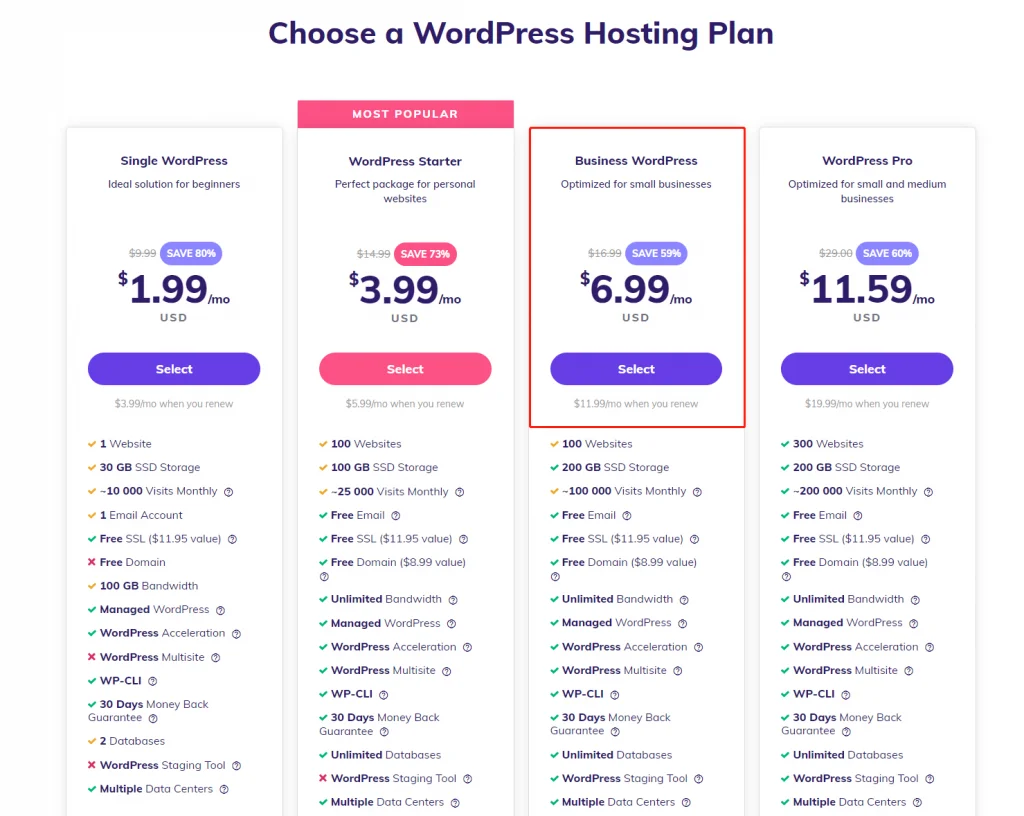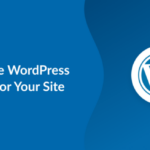[2024] Google SEO Optimization Beginner’s Guide: 20-Minute Getting Started Tutorial
Google SEO is an indispensable means of attracting traffic when we conduct overseas digital marketing. Especially for friends who are engaged in foreign trade or e-commerce independent websites, if they can obtain stable free traffic in search engines for a long time, then compared with paid advertising, the return on investment is likely to be higher.
However, in the face of a large number of Google SEO learning resources and relatively complex theoretical knowledge, many people may find it difficult to start. If you are looking for a systematic set of Google SEO learning tutorials, then you have come to the right place. I recently added a new section to my website, which is free Google SEO tutorials . I will start from the most basic basic knowledge of Google SEO, the main components of SEO optimization, to teach you how to do specific SEO. Friends in need can click on the link to learn more.
As the first blog in this set of SEO tutorials, its main purpose is to lead you across the entry threshold of Google SEO, gain a basic and comprehensive understanding of SEO, and teach you how to optimize your website and improve your search engine rankings. ranking on.
Without further ado, let’s officially start this Google SEO Beginner’s Guide!
Basic concepts related to SEO
Let’s start with a few basic questions to understand the world of SEO, including what is SEO, why SEO is so important, and its core work content.
What is Google SEO
The full name of SEO is Search Engine Optimization , which means search engine optimization in Chinese. It means that we optimize our website through some methods that comply with the search engine algorithm rules to improve its SERP page (search) in search engines such as Google, Bing, Yahoo, and Baidu. visibility on engine results pages) and rank as high as possible.
To put it more simply, after a lot of analysis work, we created a website that satisfies ourselves, our customers, and search engines. When users enter certain keywords in the search box, our website can stand out among many competitors, rank very high, and bring high-quality traffic.
Why do Google SEO?
Although social media has developed rapidly in recent years, allowing people to obtain information in more diversified ways, search engines are still the mainstream way for users to find content. In addition to daily answers to questions, users will also search on Google Search for products and buy directly online.
Looking around the world, among so many search engines, Google’s market share can be said to be unparalleled. The data of 91.44% alone can let us know the importance of Google promotion.
With Google SEO, we can naturally attract users to our website when they search, instead of paying all the time to buy exposure and clicks. For foreign trade and e-commerce independent websites, the return on investment (ROI) of free traffic obtained through SEO optimization is often much higher than that of paid advertising.
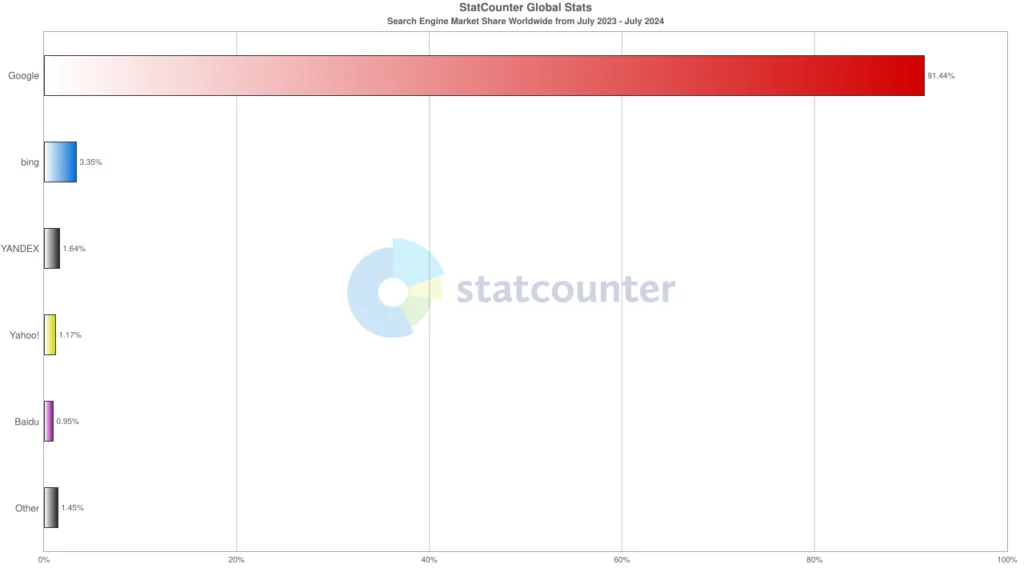
This is a picture of search engine market share that I downloaded from StatCounter . We can see that in the past year, Google alone occupied 91.44% of the market share, Bing accounted for 3.35%, Yandex accounted for 1.64%, Yahoo! accounted for 1.17%, Baidu accounted for 0.95%, and the rest 1.45% market share is divided by other unknown search engines.
With this market share, is there any reason why we don’t do marketing and promotion on Google? Is there any reason not to do Google SEO?
Next, let’s take a look at the advantages of Google optimization:
long-term organic traffic
One of the most obvious advantages of SEO is that the traffic lasts for a long time and is stable. Unlike paid advertising, once you stop charging money, you can no longer bring traffic to the website.
If we do SEO optimization through formal methods, even if the Google algorithm is constantly updated, although the website traffic will fluctuate, it will not be beaten to death with a stick, and it can still bring some traffic. In the later stage, as long as you continue to maintain normal search engine optimization methods, you can restore the traffic and even bring more traffic to the website.
Increase user trust
According to Semrush’s ” 2023 Search Report “, when users conduct searches on PC, 45.1% of people will click on natural ranking results, and only 1.8% of people will click on paid advertisements.
This result occurs because users tend to think that naturally ranked websites are more reliable and have a stronger sense of trust. Therefore, improving website rankings through SEO can help increase brand exposure and trust.
Long tail words have higher conversion rates
More specific search needs usually mean higher conversion rates. Let’s look at two examples. The search intent of users who search for “ sports shoes ” is relatively vague, while the needs of users who search for “ summer breathable women’s sports shoes ” are much clearer, and the conversion rate of the latter is often higher than that of the former.
We call this kind of specific keywords long-tail keywords. If these words can be used to bring traffic to the website through advertising, the number of ad campaigns and ad groups will take off. But if we use SEO optimization, we can easily rank these long-tail keywords on the homepage and bring traffic and conversions.
What are the main tasks of SEO?
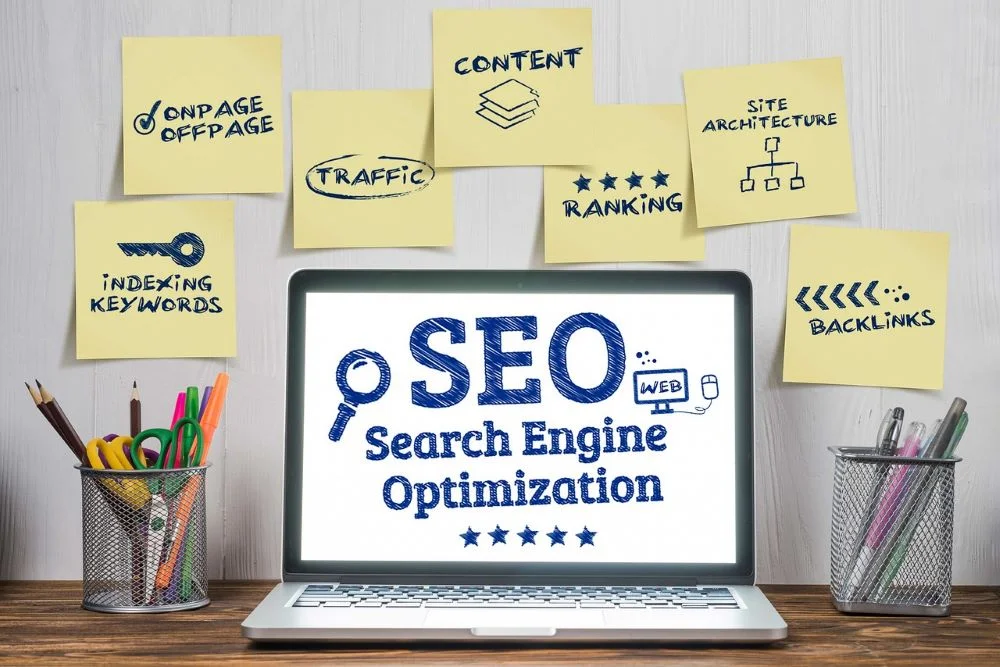
We have talked a lot about the basic introduction of SEO before. Next, we will talk about how to do Google SEO. Generally speaking, SEO is divided into the following aspects of work:
- Keyword analysis : Use tools to collect industry keywords and long-tail keywords, as well as keywords that competitors have ranked, group the keywords into groups according to different search intentions, and wait for the next step.
- Competitor analysis : Mainly to check whether the competitor’s website has high weight, whether there are traces of SEO optimization, how effective it is, the quality of external links and other data information. In addition, we can also learn from competitors’ framework design, promotion methods, business philosophy, etc.
- On-site optimization : This is generally SEO work performed within the website, such as title tag optimization, meta description optimization, image ALT attributes, keyword deployment, etc. Although they are relatively basic SEO optimization work, they play a very important role in the later SEO results.
- Content optimization : What is emphasized here is not only that the content of blogs or articles must be of high quality, but also that the copywriting of all pages of the website, such as the homepage, product category pages, product details pages, and company introduction pages, must maintain high-quality creation.
- Off-site optimization : This generally refers to the construction of external links of the website, that is to say, obtaining a link to your own website from a high-weight website is equivalent to them voting for our website, which is beneficial to the SEO ranking effect.
- Data analysis : The main purpose here is to see whether our SEO work is effective. Regularly track the keyword rankings to see whether the website exposure has increased and whether the number of visiting users has increased. If the data is increasing, it means that we The general direction is correct, just keep on keeping on.
The difference between white hat SEO and black hat SEO
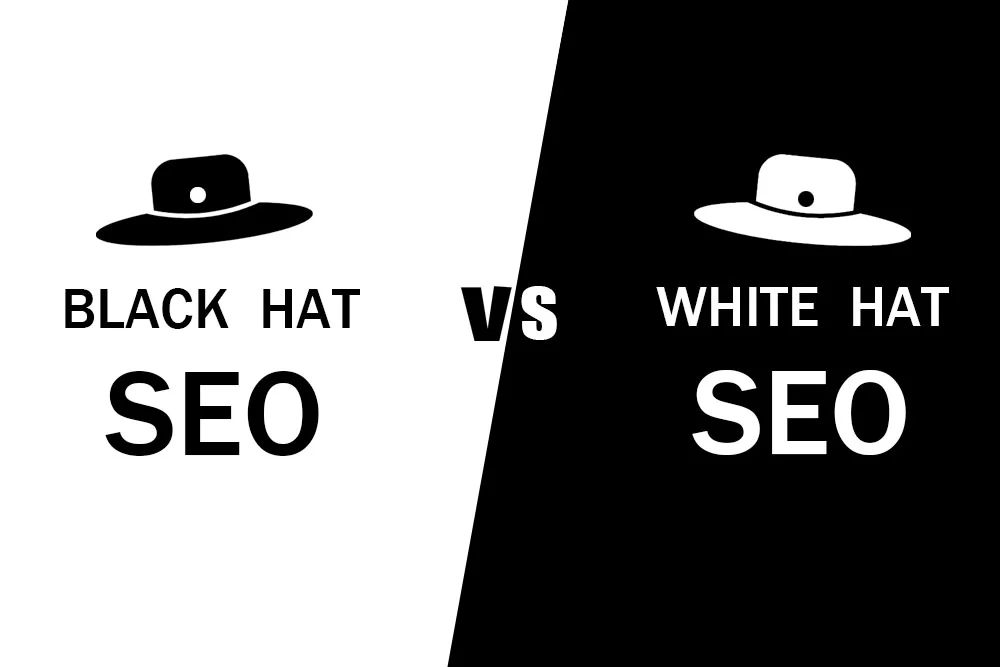
In fact, there are several SEO optimization methods. The most common one we have been discussing is white hat SEO. In addition, like many gray or black industries, there are also gray hat SEO and black hat SEO methods.
- White hat SEO : White hat SEO follows Google’s optimization guidelines and improves website rankings through legal and rule-compliant means, such as high-quality content creation, on-site optimization, and obtaining high-quality external links.
- Black Hat SEO : Black Hat SEO refers to the use of cheating methods that do not comply with search engine rules to quickly improve website rankings. Common black hat techniques include keyword stuffing, hidden text and links, purchasing a large number of low-quality external links, content farming, etc. Although this method may be effective in the short term, once discovered by search engines, it may cause the website to be demoted or banned.
- Gray hat SEO : Gray hat SEO is between white hat and black hat, using some techniques that are not explicitly prohibited by search engines for optimization. For example, slightly exaggerating the content, slightly manipulating external links, or using covert push techniques. Although gray hat SEO has certain risks, it may bring better results in the short term.
Let’s use a table to more intuitively look at the differences between these three optimization methods:
| Features | white hat SEO | Black Hat SEO | Gray Hat SEO |
|---|---|---|---|
| Follow the rules or not | Fully follow search engine guidelines | Completely against search engine rules | Partial compliance with the rules, somewhere between legal and illegal |
| Common optimization methods | Reasonable on-site optimization High quality content creation Get natural external links |
keyword stuffing Hide text and links Buy external links in bulk |
exaggerate content Occasionally manipulate external links Implicit push technology |
| Are there risks | No risk , long-term results are significant | The risk is high and being discovered may result in demotion or ban. | The risk is medium , which may lead to a short-term ranking improvement, but there is a risk of being demoted. |
| SEO effective speed | Slow- acting, but long-lasting | Quick results , but not long-lasting | It takes effect quickly , but the effect may be unstable |
| Durability of effect | long term stability | Effective in the short term, but unstable in the long term | The short-term results are better, but there is a risk of being punished in the long-term. |
| input cost | High cost of time and effort, high return on investment | Low investment, high returns possible in the short term, but high long-term risks | Moderate investment may result in higher returns in the short term, but there are risks in the long term |
| Applicable scenarios | Suitable for businesses and websites that want long-term and stable growth | Generally used in black hat industries or websites that want to gain traffic quickly, but not recommended | Suitable for optimization projects that need to increase traffic in the short term but still want to maintain a certain degree of legitimacy |
The difference between SEO and SEM
The two terms SEO and SEM are also two traffic diversion methods that many friends will confuse. I will briefly introduce them here. If you want to know the detailed differences between them, you can read a blog I wrote before: ” SEO” VS SEM: Their Definitions and Differences “.
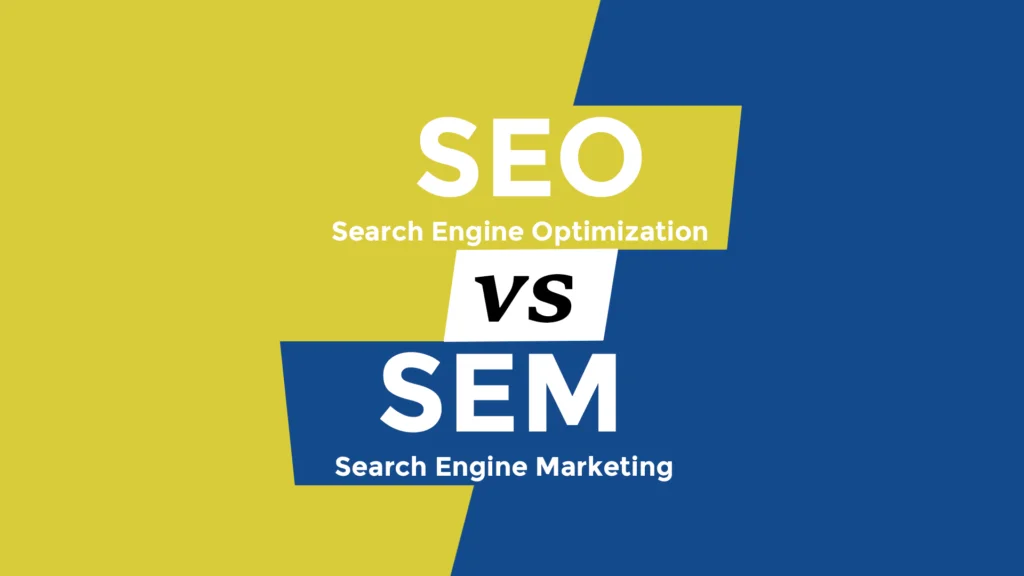
Simply put, SEO is to improve the ranking in natural search results by optimizing the content and structure of the website, while SEM is to purchase advertising space directly in the search engine results page through paid advertising.
When we enter certain keywords into the search engine, some sponsored ads will appear at the top of the search results. These websites are ranked at the front through SEM.
Some websites below the advertisements are the positions we often say need to be obtained through website SEO optimization, and the competition is particularly fierce.
Here we also use a table to visually compare the differences between the two:
| Features | SEO | SEM |
|---|---|---|
| definition | Improve rankings in organic search results by optimizing website content and structure | Buy advertising space directly in search engine results pages through paid advertising |
| main goal | Improve natural rankings and obtain long-term and stable natural traffic | Get instant traffic with ads |
| input cost | The initial investment is higher, but the later costs are lower | Ongoing payment, charged based on ad clicks or impressions |
| Effective speed | The results are slow and require several months of investment in the early stage. | It works quickly , but the traffic will stop after the delivery is stopped. |
| Durability of effect | Effective for a long time , traffic will accumulate over time | Effective for a short period of time , traffic disappears when ads stop |
| Applicable scenarios | Suitable for websites that want to gain long-term organic traffic | Suitable for short-term promotions or websites that need to attract traffic quickly |
| Ranking placement | Natural search results area (non-advertising area) | Ad areas at the top or bottom of search results pages |
| User trust | High , users are more likely to click on natural search results | Relatively low , some users skip ads and click directly on natural search results |
| Management difficulty | Requires continuous optimization and content updates | Advertising budget and keyword bidding need to be adjusted regularly |
Things to know about search engines
After introducing the basic concepts of SEO, let’s take a look at the basic knowledge related to search engines. After all, only by understanding the principles of search engines can we better carry out SEO optimization work.

How search engines work
Generally speaking, the working process of a search engine can be roughly divided into 3 stages:
Crawling:
Search engines use “crawlers” or “spider” programs to discover web pages on the Internet. In addition to the submitted sitemap, the sources of web pages also include countless links on the Internet. Crawlers regularly visit and analyze web content to discover new pages or updated content.
You can simply understand it as a librarian holding a scanner to scan various books in the library in preparation for the next step of classifying the books.
(Indexing):
After crawling so many web pages, they must be stored somewhere. The search engine will process the content and store it in a huge database, which is the “index library”. This process is called indexing.
To put it simply, when we usually go to the library to look for books, we search according to different categories. We can’t just go around in circles like a headless fly. The indexing process is similar to this. The content is classified and organized according to its themes, keywords and other characteristics, and then the content is stored in the database.
Ranking:
When a user enters a query into a search engine, they do not get the answer directly from the Internet, but from the search engine’s index library. In this process, the search engine will use its algorithm to find the results most relevant to the search terms from the index library and sort them by relevance.
In plain English, we tell the librarian that we want to borrow a certain book or material on a certain topic, and the librarian will help us select the books we want from the “bookshelf” and sort them according to certain rules. Put the book in front of us and let us choose the most suitable book to take away.
Understanding the working steps of search engines can help us better understand subsequent optimization work. Of course, here is just a brief description of its working principle. In fact, it is far more complicated than this. If you are interested, you can read my blog, which introduces the working principle of search engines in detail.
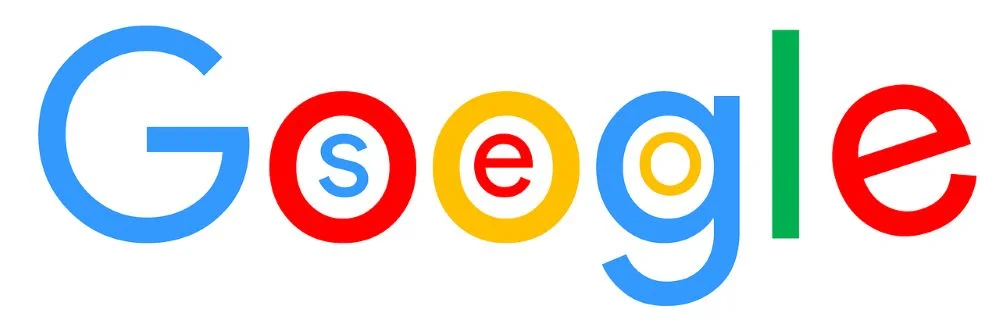
Important Google algorithm updates in recent years
Google’s algorithm is updated every year, and from time to time you will see a large number of websites being penalized to zero traffic. In fact, you don’t have to worry too much about Google’s algorithm updates, because its core goal is to provide users with better content.
As long as our website is fully optimized according to white hat SEO, even if the core algorithm is updated, the impact on the website will not be too great, and slight traffic fluctuations can be recovered after continuous optimization for a period of time.
Next, let’s take a look at some of Google’s more significant algorithm updates in recent years:
| Algorithm name | Release time | Main updates | what should we do |
|---|---|---|---|
| Panda (Panda) | February 2011 | Mainly targets low-quality content and content farms, lowering their rankings | Create original and high-quality content and avoid content stuffing and low-quality external links |
| Penguin | April 2012 | Combat over-optimization and spam links, especially low-quality external links | Focus on quality rather than quantity of backlinks and maintain natural link building |
| Hummingbird | August 2013 | Emphasis on semantic search to better understand users’ search intentions | Focus on user search intent and create content that answers user questions |
| Mobilegeddon | April 2015 | Optimize mobile friendliness, websites that perform poorly on mobile devices will be lowered in rankings | Ensure the website is easy to use on mobile devices and enhance the mobile experience |
| RankBrain | October 2015 | Leverage machine learning to better understand search queries and improve relevancy | Improve content relevance and user satisfaction, and optimize user experience |
| BERT | October 2019 | Emphasis on natural language processing to better understand search intent and context | Write content with context and user intent in mind and avoid overly technical or vague descriptions |
| Core Web Vitals | June 2021 | Focus on user experience, especially page loading speed, interactivity and visual stability | Improve website loading speed, reduce visual changes, and enhance the overall user experience |
| Helpful Content | August 2022 | Focus on combating low-quality or irrelevant content so that more useful content ranks higher | Create content that truly helps users and avoid content that is automatically generated or created purely for SEO |
| August 2023 Core Update | August 2023 | Strengthened the identification of high-quality content, especially the emphasis on originality and professionalism | Keep your content original, professional and of real value |
I don’t know if you have noticed it, but every major algorithm update is more or less related to high-quality content and user experience. This also tells us that if we are doing Google SEO optimization now, we must abide by the SEO guidelines and stop doing things that violate the rules. It’s a matter of fact, otherwise it will be difficult to obtain a stable ranking.
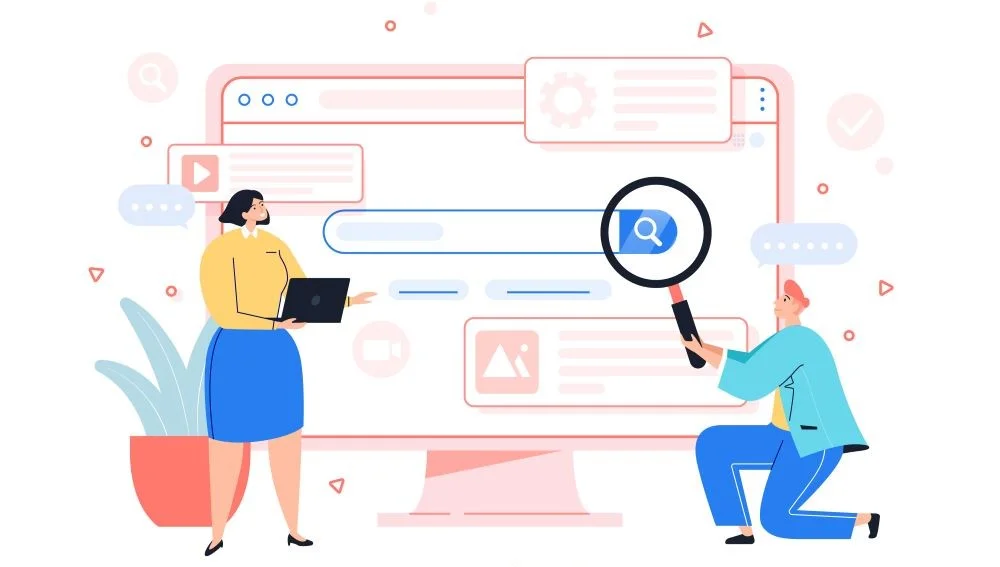
Common SEO ranking factors
The reason why I put this section in is to tell you about some of the more important Google ranking factors at present, so that when doing search engine optimization in the later stage, you can try to meet the seo optimization standards.
There are more than 200 actual ranking factors. Except for Google insiders, no one knows what they are. We can only know some ranking factors through some official Google words or verification by foreign experts.
- Content quality : High-quality content is one of the core elements of Google ranking. Google hopes that users can quickly find useful information through search results, rather than click again and again, and finally leave dissatisfied. So we must create high-quality content based on search intent, ensuring originality and relevance.
- Page loading speed : Page loading speed not only affects user experience, but also affects SEO rankings, and a website with slow loading speed may result in high bounce rate and low dwell time. We can improve web page loading speed by compressing images, enabling browser caching, CDN technology, etc.
- Mobile friendliness : With the popularity of mobile devices, Google has made mobile-first an important ranking factor, and now the mobile traffic trend has been increasing, with more and more users accessing our website through mobile phones. We should ensure that our website is designed to be responsive, and sometimes we need to optimize page loading speed specifically for mobile.
- High-quality external links : High-quality external links are an important factor that Google uses to evaluate the credibility and authority of a website. If our external links come from authoritative websites, it will help the website’s ranking even more. Therefore, we must work hard to obtain external links from high-authority websites related to the industry, rather than external links from some junk websites.
- User experience : User experience when visiting our website is also one of the important factors in ranking. Google will analyze user behavior, such as bounce rate, dwell time, click-through rate, etc., to determine the relevance and quality of the page. We want to ensure that the site navigation is clear, the pages are well laid out, and the content is attractive and helpful to users.
Friends who want to know more about Google’s ranking factors can read this blog: The 10 most important Google SEO ranking factors , which tells you in detail what important ranking factors there are and what ranking factors are widely circulated on the market. .
In the previous chapters, I have introduced in detail the basic concepts of SEO, white hat SEO and black hat SEO, SEO and SEM, how search engines work, Google algorithms and ranking factors. These theoretical knowledge lay a solid foundation for us to understand Google seo. However, it is useless to just know the theory. You will know it once you see it, but it will be useless once you do it. In order to avoid this happening, I will tell you how to optimize Google SEO.
Domain name application
I put domain name application as the first step in the SEO practical guide. This is because many people always hesitate for a long time because of the choice of domain name and are unable to officially start building and optimizing the website.
Regarding domain names, some opinions have existed in everyone’s memory for many years, but many people have not iterated on the corresponding information, such as feelings about old domain names, keyword domain names, short domain names, etc. Next, I will tell you exactly what to do at each point.
Are old domain names good for SEO optimization?
There has always been a phenomenon that when you are preparing to perform search engine optimization on your website, most people who know something about Google SEO optimization will recommend that you choose an old domain name first. Because they think that the weight of the old domain name is relatively high, and search engines will be more likely to trust your website. In other words, the old domain name has been in operation for many years and may carry more resources. When you optimize the website later, it will be easier for keywords to rank. .
This approach may have been helpful a few years ago, but in 2019, Google’s John Mueller replied on Twitter that neither the old domain name nor the new domain name had any impact on website rankings. Below is a screenshot of the original Twitter.
John Mueller denies domain age helps rankings
John Mueller claims that Google will not have any weight in favor of new domain names
In addition to the denial by Google officials above, there should be some other big names on the Internet who have expressed some opinions on the age of domain names. Friends who want to know more can search for relevant information on the Internet.
In short, the age of the domain name will not greatly improve the website ranking. In the future, when applying for a domain name, everyone will be less affected by some old opinions and avoid ending up choosing a domain name that has nothing to do with their own products in order to get an old domain name. situation occurs.
Should the domain name contain optimized keywords?
In addition to domain name age, the second misunderstanding about domain names is that the domain name must include product keywords or other target keywords, such as chinaledlightwholesale.com.
First of all, I wonder what is your first reaction when you see the domain name above? Whether it is complex and difficult to remember, it will take some time to break up the sentences, and it will not leave much of an impression after reading it.
Nowadays, countless new domain names are generated every day. How can a domain name with no characteristics like this be impressive among the vast army of domain names?
You can think about why some short domain names can be auctioned for hundreds of thousands, millions or even tens of millions. It is because they are generally relatively simple and easy to remember, and can leave an impression of your brand in the minds of customers.
Secondly, John Mueller also said that the fact that a domain name contains a keyword is not a factor in how Google will rank for that keyword.
…just because keywords are in a domain name doesn’t mean that it’ll automatically rank for those keywords.
Is the shorter the domain name, the better?
Many people skip the two misunderstandings of age and keywords, and accidentally step into the third pitfall, which is to choose the shortest domain name.
Suppose there are two domain names below, which one would you choose? electromagnet.com and eltmag.com, some people may choose the second domain name because it is shorter. However, we generally recommend choosing the first domain name. Although it looks longer, the domain name itself is meaningful, it is a complete word, and it is catchy to read and easy to remember. The second domain name is a short domain name composed of irregular letters and does not carry a deeper meaning.
It is still John Mueller’s reply on Twitter in February 2021. The domain name and the length of the URL are not factors in Google rankings.
Domain name and URL length are not Google ranking factorsDo I have to choose .com?
Although Google or other search engines have not explicitly stated that they will increase ranking weight for domain names ending in .com, it is generally recommended to register a .com domain name.
Under normal circumstances, if someone tells you a domain name, would your first reaction be xxxxxxxx.com? In fact, when .com first came out, it meant commercial, so many companies registered .com domain names, and this tradition has not been broken yet.
Registration platform
If it is a personal blog or a company that focuses on foreign markets, you can choose overseas platforms to purchase domain names. No registration is required. The mainstream purchase channels are as follows:
If the target market is domestic and you mainly do Baidu SEO, you can go to Wanwang to apply for a domain name, but registration is required.
The domain name application platforms above are ranked in no particular order and will not be described in detail. You can click on the website to learn more. If necessary, I will write a special article later to introduce the differences between these domain name registrars.
Domain name selection summary
In fact, so much has been said above, here are the following points for domain name application.
- as short as possible
- meaningful
- Easy to remember
- choose.com
After introducing the basic knowledge of domain name application, let’s look at website positioning. For a successful SEO strategy, clear website positioning is the first priority. Only by clarifying the industry, business model and target market that the website will serve can we develop a more efficient SEO optimization strategy.

Website positioning must be precise
In fact, domain name application also needs to be combined with website positioning. If possible, try to choose a domain name that is related to your own products or services, which will help users understand. Suppose you are in the home appliance industry, but you apply for a pharmaceutical-related domain name. Is this likely to mislead people?
So, before designing the website framework, what factors should we consider for website positioning? There are mainly three aspects: industry positioning, business model positioning and market positioning. Next, I will discuss these in detail.
Industry positioning
First of all, we need to clarify which industry category our website belongs to. When creating a new website, you generally don’t span multiple industries. Avoid the situation where you just uploaded medical products, but then uploaded lifestyle products soon after. Cross-category will make the website look like a hodgepodge, lacking professionalism and reducing user trust, but if you are building a large-scale e-commerce website, you can do this.
In addition, it must be mentioned that the difficulty of optimization is different in different industries. For example, some industries have difficult keywords and strong competitors. Even if you write high-quality content and send a lot of high-quality external links in a short period of time, you may still not be able to rank higher than your opponent. This situation requires time to settle. . Therefore, before determining the industry, you can first analyze the difficulty of SEO optimization in each industry, and then choose a field that is more suitable for deep cultivation.
Finally, I would like to mention that generally different industries have their own “exclusive color matching”. For example, the pharmaceutical industry may have more blue, and the environmental protection industry may have more green design elements. These design elements are often combined with the colors of the brand logo to further enhance brand recognition.
Business model positioning
After determining the industry, it is necessary to confirm which model the completed website will mainly rely on to make money. Is it e-commerce, information services, or social forums? Or is it just a corporate website that showcases your company’s image? For example, the main purpose of a foreign trade company building a website is to obtain inquiries, a cross-border e-commerce independent website is mainly to allow customers to place orders on the website to facilitate transactions, and a personal blog mainly obtains income through advertising.
The operating models of different types of websites are still different, so we must determine the business model of our website in the early stages of building a website, so that subsequent SEO strategies can more accurately serve business goals.
market positioning
If a new website rushes into a highly competitive market with all its strength from the beginning, it is likely that it will not achieve the results you want for a long time. Next, we will look at two situations: large companies and small and medium-sized companies.
If it is a large company, generally designers, technicians, operations personnel, and data analysts are all ready, and the entire team will cooperate to operate a website. Each operation staff is assigned different categories for SEO optimization. If problems are found during work, they can discuss and solve them with other team members in time. They are often equipped with dedicated content operations personnel to regularly output high-quality blogs every week. Would it be easier for a website like this to get ranked?
But for ordinary small and medium-sized companies, not only are the resources and manpower not as good as those of large companies, but also one person often wears multiple hats. Webmasters are not only SEO optimizers, but also artists, technicians, content creators, external link analysts, etc. Then he (she) most likely does not have that much energy to optimize products in too many categories. It is also possible that during the optimization process, you find that there are many pages in a certain category that are not indexed by Google. You have been trying to find a solution. When you finally solve the problem, you look back and find that the website content has not been updated for a long time.
In order to avoid the phenomenon of focusing on one at the expense of others, it is generally recommended to start with a market segment with less competition. For example, you are a merchant selling cables, and cables can be divided into power cables, shielded cables, computer cables, signal cables, coaxial cables, marine cables, mining cables, etc.
You can first analyze the SEO optimization difficulty of different types of cables and understand the keyword traffic, index volume, competitors, etc. Assuming that the competition in all aspects of mining cables is relatively low, we will optimize this category first. Generally, long-tail keyword rankings for products under this subdivision are less difficult and are suitable as target keywords for obtaining traffic in the early stages of a new website.
Keyword analysis
After determining the industry and market positioning of the website, the next step is to conduct keyword analysis. This is a very critical step because it determines the search terms through which our website will be found by users.
This step requires collecting a series of keywords with different search intentions. It is necessary to analyze the intention behind the customer’s search for this keyword, how much traffic it can bring to the website, and the degree of competition in keyword rankings.
How to find and select keywords
There are many tools for keyword research, and I will recommend some common free and paid tools for you to use.
Find keywords with free tools
The most common method is through the Google drop-down search box and bottom search suggestions
For example, if we enter the keyword ” mining cable ” in the search box, some related searches will automatically appear at the bottom of the search box. These words are frequently searched by users.
Related keyword suggestions prompted below the Google search box
After entering a certain keyword and getting the search results, we pull the browser to the bottom, and we will find that there are also some related searches at the bottom of the search results page, such as “mining cable services”, “electrical cables for mining use”, these are also users Search for more keywords.
Related keyword suggestions at the bottom of the Google keyword results page
You can collect keywords related to your products by repeatedly entering different keywords, and then organize them into a table.
You may think this method is too cumbersome and time-consuming. You can also use some free keyword analysis tools to do keyword research, such as ChatGPT, Keyword Tool, Google Keyword Planner, etc.
Next, I use the Keyword Tool as an example. The free account can only view some keywords. The usage of other tools is similar, so I won’t introduce them in detail.
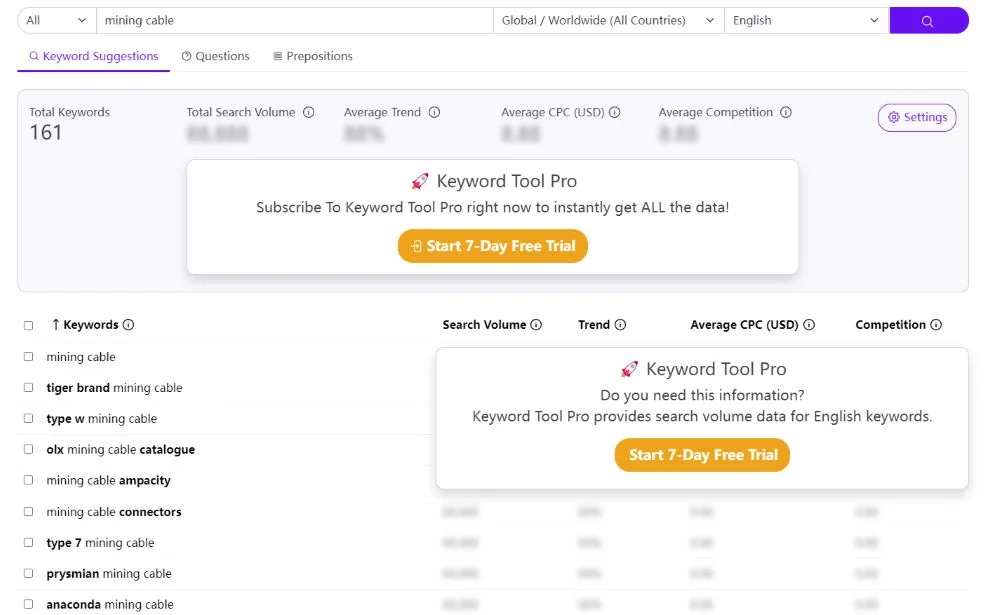
Use paid tools to analyze keywords
A lot of data cannot be seen in free tools. If you not only want to see relevant keyword recommendations, but also want to see the search volume, ranking difficulty, CPC price and other data of each keyword, it is best to buy a paid tool.
For example, if we enter ” signal cable ” in Mangools KWFinder, the interface we get will be as shown in the figure below. It not only has hundreds of related keyword suggestions, but also traffic trends, monthly search volume, CPC price, PPC competition intensity, and KD Index and other data.
A large number of related keywords compiled by paid tools
Other paid tools have similar functions, so I won’t introduce them too much here. You can just pick one.
How to look at keyword metrics
After obtaining the keyword list, understanding and analyzing the keyword data is the key to the next step. Here are explanations of some common indicators:
- Search : Search volume refers to the number of times a keyword is searched by users within a specific period of time. Generally speaking, the higher the search volume, the greater the potential traffic for that keyword. However, you should also be careful not to blindly pursue keywords with high search volume. Words with too high traffic may be more difficult to rank.
- KD (Keyword Difficulty) : Keyword Difficulty (Keyword Difficulty) refers to the intensity of competition for this keyword in search results. Usually expressed as a percentage, the higher the value, the harder it is to rank well for that keyword.
- CPC (cost per click) : For advertising friends, click cost is a key indicator. It represents how much you pay for each click. This indicator can help us determine the commercial value of a keyword.
Core keywords and long-tail keywords
In the work of keyword analysis, we often hear the two concepts of “core keywords” and “long-tail keywords”, so what is the difference between them?
- Core keywords : This is the most important keyword of our website, which is directly related to the main business of the website. It is usually relatively short and has a large search volume. For example, if the website sells various shoes, then “shoes” is a typical core keyword.
- Long-tail keywords : Compared with core keywords, long-tail keywords are more specific and usually contain three to five words. For example, “red high heels” is a long-tail keyword. Although the search volume is low, these keywords tend to have less competition, it is easier to obtain traffic through precise content, and the conversion rate will be higher.
Analyze keyword search intent
Understanding the user’s search intent (Search Intent) is an important part of keyword analysis. Different keywords may reflect different needs of users. For example, some users are looking for information, while others are comparing products or preparing to purchase a certain product. Therefore, we need to conduct an in-depth analysis of the search intent of keywords to ensure that the website content can meet the real needs of users.
Here are some common search intent types:
| Search intent type | describe | Example keywords | Content creation advice |
|---|---|---|---|
| 信息类(Informational) | Users are looking for details or answers on a specific topic, usually for the purpose of gaining knowledge. | “How to lose weight quickly” | Create detailed guides, tutorials, FAQs, and more to help users solve their problems. Keep the content concise and clear, and include useful tips and steps. |
| Navigation | Users already know a specific website or page they want to visit and use keywords to navigate directly to that website. | “Facebook login page” | Optimize pages for brand names, specific products or services so users can quickly find what they want to access. |
| 商业类(Commercial Investigation) | A user is researching a product or service for future purchase, but has not yet made a final decision. | “Best budget smartphones 2024” | Provide product comparisons, user reviews, buying guides and other content to help users make purchasing decisions. The content should be objective, list the pros and cons, and provide links to purchase. |
| Transactional | The user has decided to buy and uses specific keywords to make the purchase. | “Buy iPhone 15 online” | Create optimized product pages that provide detailed product information, purchasing options, customer reviews, and a clear buy button. Content should directly address users’ purchasing needs and provide a seamless shopping experience. |
If you want to know more about search intent, I highly recommend checking out my other blog: ” What is Search Intent “, which introduces all the information about search intent.
SERP (search engine results page) analysis
If you analyze keywords and only look at its search volume, CPC price, keyword difficulty, index volume and other data without analyzing the search engine results page, then this approach is also completely wrong.
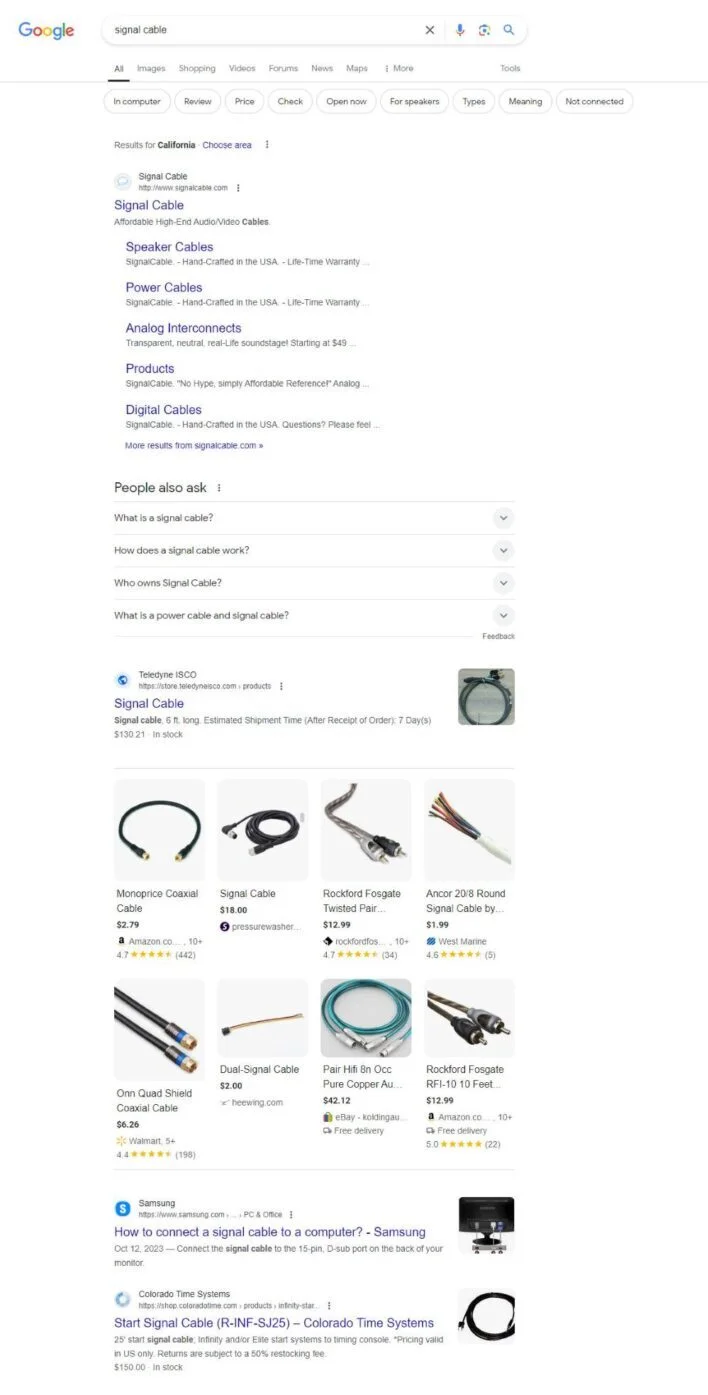
The specific steps are to enter keywords into the search box and analyze which type of page is mainly ranked first in the results page. Is it the homepage of the website? Product page? Or a blog page? If it is a product page, is it more C-side or B-side?
Now that the competing pages are determined, what is the overall weight of this website? How much traffic do you get every month? What is the ranking of the basket of keywords we analyzed above? Is the website content of high quality? Can we create better content and rank above it for relevant keywords? Here are just some examples, and the specific steps can be adjusted according to the actual situation.
We need to formulate different optimization methods for different search intentions. The specific analysis ideas will not be elaborated here. Interested friends can read further reading: ” Common Google SERP Types “.
Create content that users want to see
Finally, based on the results of our analysis above, creating content that users really want to see around search intent is the key to SEO success. To do this, the content must accurately meet the user’s needs, answer the user’s questions, and match the user’s search intent in form.
Anyway, when we do Google optimization, we must always put the best content for users first. Only by meeting this requirement can our website stand out in the fierce SEO competition.
Google SEO on-site optimization
On-site optimization is a very important part of SEO, which directly affects how search engines crawl and understand our website content. Through reasonable on-site optimization, we can improve the accessibility and readability of the website, thereby improving search engine rankings.
Website frame design
Website framework design is like the skeleton of a website, determining how users and search engines browse and understand our site. A good website framework should not only facilitate user navigation, but also facilitate search engine crawlers.
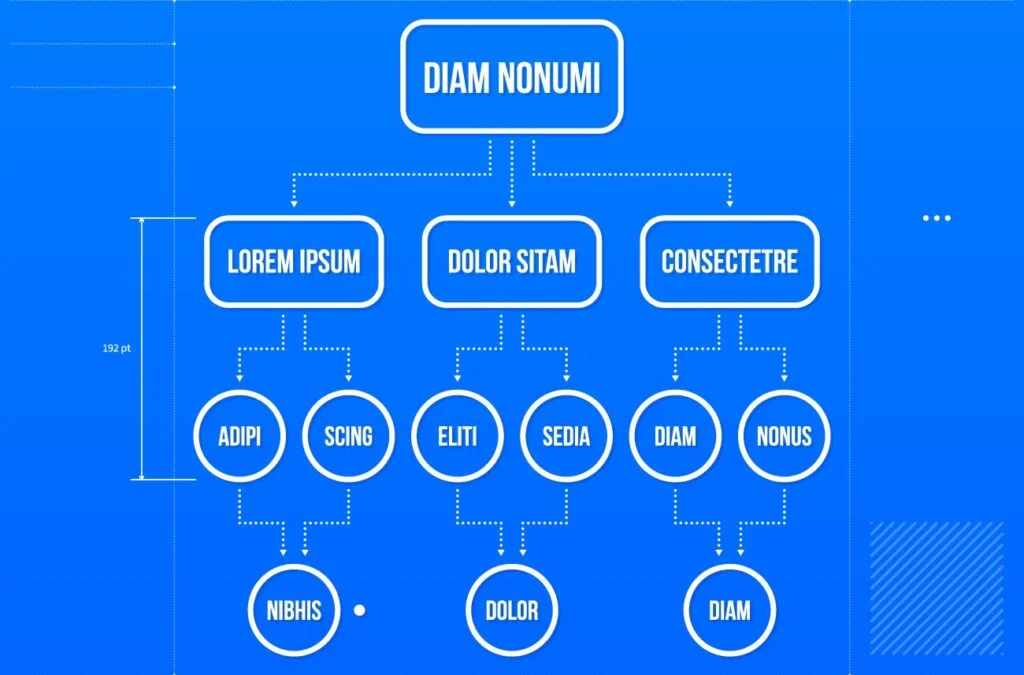
It is generally recommended to use a flat website structure , that is, home page – column page – inner page. This structure requires only three to four steps for search engine spiders to reach the content page, crawl the content, and index it. And for users, the flat website framework can also intuitively find products of a certain category at the front desk, avoiding repeated or invalid clicks.
Keyword deployment
Although Google is getting smarter and can understand what the content of web pages is about, naturally inserting keywords is also an essential step in SEO optimization work.
We need to reasonably deploy keywords in the title, body content, URL, ALT tag, meta tag, etc. We can use a combination of core keywords and long-tail keywords to ensure that enough search scenarios are covered. However, we must avoid keyword stuffing. The most important thing is to let everything take its course. Don’t insert keywords just for the sake of inserting keywords.
Title tag (meta title) optimization
Title refers to how our website is displayed on the search engine results page. If you want to display your title completely, it is generally recommended to be less than 60 characters (580px). Writing a good title can increase the click-through rate of the page, but whether the page can be ranked on the home page or first depends on whether the content quality of the web page is good enough and whether it meets the user’s search intent.
The blue part is the page title
According to my SEO optimization experience, when our page is displayed on the results page, it may not display the title we wrote ourselves. Google will sometimes appropriately modify our title and description to make it more in line with the user’s search intent.
Description tag (meta description) optimization
The description tag is a text introduction below the title tag. Although it will not directly affect the ranking, it will affect the click-through rate of the page. The description tag should succinctly summarize the content of the page, be between 150-160 characters, and include the main keywords.
A good description tag should not only attract users to click, but also let users clearly know what content they will see after clicking. This part can be regarded as your advertising slogan in the search engine results page, attracting users to click to enter the website.
For information on how to optimize title tags and description tags, you can read my blog: ” How to Optimize Title Tags and Description Tags .”
Web URL optimization
Although it was said earlier that URL is not an important factor affecting rankings, it is generally recommended to use shorter URLs. If your article name is very long, you can appropriately delete some words to form a new URL. As shown below:
The page URL can be inconsistent with the title. Core keywords are extracted to generate a new short URL.
We can see that although the title of this blog is long, its URL is very short, /best-led-strip-lights, instead of the default /best-led-strip-lights-2021-add-a- little-rgb-to-your-life.
In short, a qualified URL should be short, clear, and contain the core keywords of the page. It is best to use hyphens to separate words in URLs and avoid using underscores or other symbols. In addition, keep URLs static and avoid complex parameters or symbols.
H tag optimization
H tags are used to define the title hierarchy of web page content, in descending order from H1 to H6. Reasonable use of H tags helps search engines understand the structure of the page. H1 is generally the main title of this page, and each page can only have one H1 tag. The remaining H2, H3, H4 and other tags are used for the subtitle part to make the page structure clearer.
Image Alt attribute optimization
Alt text was originally (and still is) intended to allow visually impaired users to understand content using a screen reader. Setting alt text for each image not only provides a better user experience, but also helps the website gain image search traffic.
Although Google’s image recognition technology has made great progress in the past few years, crawlers still can’t “see” images on website pages like we can, so we have to help it identify the image content.
Alt tags should be concise and to the point, containing the core keywords of the image, but don’t stuff them with keywords. Although everyone knows that you need to fill in the Alt attribute of the image, it often becomes keyword stuffing just like the title. Whether it is title or Alt, we recommend filling in a descriptive sentence in order to allow search engines to better understand the meaning of the image. Examples are as follows:
<img src="dog.png" alt="a brown dog is running in the park">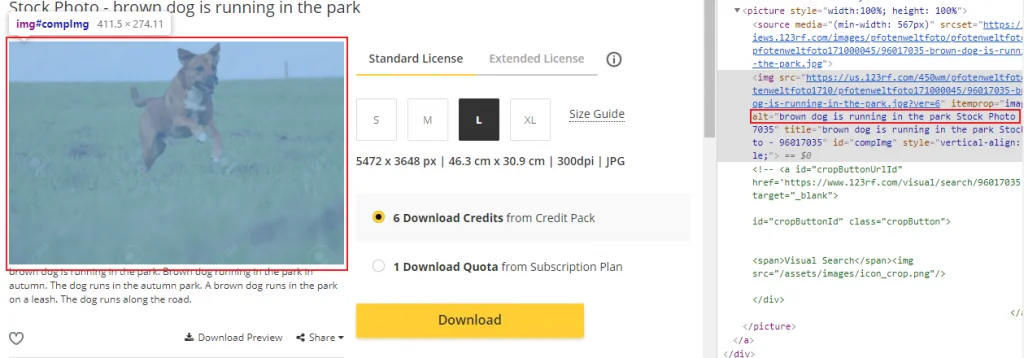
In-site link optimization
Internal links are generally used to associate related pages and transfer weight to each other. A reasonable link structure within the website can not only improve search engine indexing speed, but also transfer weight to important pages of the website.
Internal links can also be used to build a “Content Hub”. For example, you have written an article about topic A, but it is often difficult to obtain rankings for core keywords based on this article alone. At this time, you can continue to create articles A1, A2, A3, A4, and A5. Then use internal links to transfer the weight to article A, and finally obtain the ranking of related keywords.
One thing to note about internal links is not to abuse them. You only need to add links in appropriate places. The purpose is to tell search engines that the linked pages are related to the topic.

Anchor text optimization
Anchor text is the clickable text part of the link within the site, so everyone can just let it take its course. Try to make the anchor text short and relevant, and then use different keywords to make the anchor text. Don’t use the two or three over and over again, and don’t deliberately insert core keywords. The most important thing is to let nature take its course.
If you don’t know how to optimize anchor text or how to edit anchor text, you can read my other blog: ” What is Anchor Text “.
High quality content updates
If a website wants to have a good ranking, it cannot do without the update of high-quality content. Regularly updating blogs or other quality content on your website will help Google SEO rankings. If your website has not had content updates for a long time, Google Spider crawled it once, but there was no change. Then it crawled again after a while, and the content of the website remained unchanged. Repeat this a few times, and Google spiders may no longer visit your website for a long time.
Speaking of content, there may be a situation where you write a 100% original article, but at this time another high-authority website copies your article, then it is very likely to be ranked in front of you. This is because Google has not yet established enough “trust” for new websites, and it prefers to give better rankings to larger websites. What we can do is continue to produce high-quality original content and strive to become a high-weight website as soon as possible.

Improve content readability
In the world of SEO, content readability is an effective means of attracting and retaining users. Highly readable content is usually concise and clear, with simple sentence structures and clear logic between paragraphs, and avoids the use of overly technical terminology or complex sentence structures.
We can use features such as sentence fragmentation, clear titles, subtitles, and lists to help the web page improve the readability of the content. In addition, you can also use white space to divide the content to ensure visual simplicity and help users read the content more easily.
Content quality is more important than quantity
If a website contains a lot of junk content, it is likely to be punished by Google and cause the website’s ranking to drop. High-quality content refers to articles that can solve users’ actual problems, provide valuable information, and have a reasonable structure and smooth language.
According to my SEO work experience in the past few years, some websites can get a lot of traffic just by relying on high-quality content even without external links. A popular article can rank for hundreds or thousands of keywords and bring tens of thousands of traffic. Of course, the premise is that the content of your article is original enough, long enough, and of high quality.
Keep updating original content
High-quality content is often inseparable from original content. Google likes to include original content. If your website contains a lot of duplicate content, the page will most likely not be included.
Original content not only refers to articles written entirely by yourself, but also includes unique perspectives or analyzes of existing content. This kind of content is more likely to gain the trust and love of users, and is also more likely to be cited or linked to by other websites, thereby further improving SEO performance.
Featured snippets and featured snippets
Featured snippets and featured snippets are summaries of content displayed by search engines in the results page, usually at the top of the search results. This content can not only quickly provide users with search answers, but also significantly increase the click-through rate of web pages.
If you want to increase the chances of web content being selected as a featured snippet, it is recommended to directly answer the questions users may search for in the article and present it in a concise and clear form, such as lists and tables.
user experience
In fact, I have emphasized user experience in many sections. We have also seen in the previous algorithm that many updates are to improve user experience, which shows its importance. Next, let’s take a look at how to improve user experience.
By the way, many of the above optimization methods are also to improve the user experience. It does not mean that only the following three points are related to the user experience.
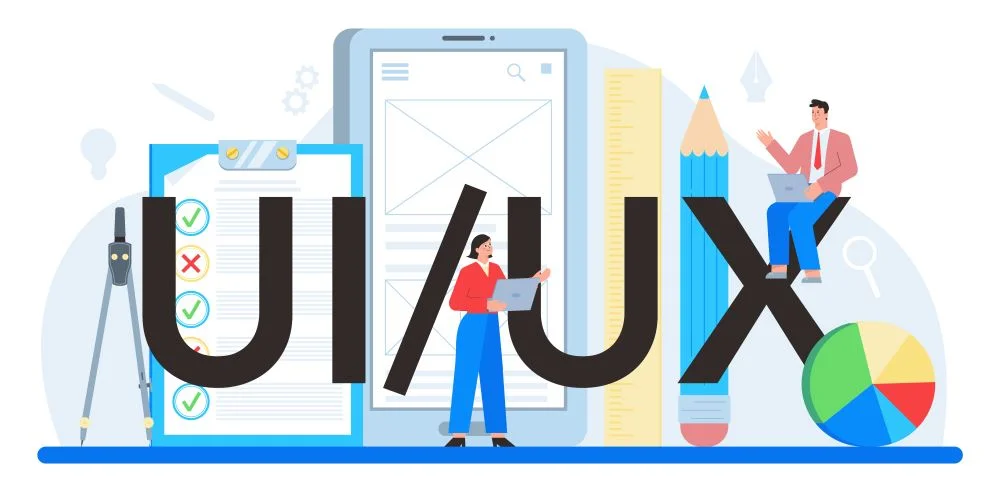
Moderate ad insertion
Advertising is one of the important ways for websites to make money, but too many ads will seriously affect the user experience. When we usually browse the web, do we find it annoying when we see a lot of advertisements?
It is strongly recommended to moderate advertising insertion and avoid pop-up ads or forced viewing video ads. In addition, ensure that the content of the advertisement is relevant to the theme of the website and does not affect the user’s normal browsing. Suitable locations include the sidebar of the page or at the end of the article, which ensures that the ad is exposed and does not interfere with user reading.
Page design and content layout
An excellent page design and reasonable content layout are crucial to user experience. The page design should be concise and elegant, with harmonious color matching and clear and easy-to-use navigation. In terms of content layout, it is recommended to follow an F-shaped or Z-shaped reading pattern to ensure that users can quickly find the core content.
Avoid overly complex designs and ensure that all content can be displayed well on different devices. This not only improves the user experience, but also helps improve the SEO ranking performance of the website.
Add pictures and videos
Visual content, such as images and videos, can greatly enhance user engagement and experience. Compared with pure text content, an appropriate amount of pictures and videos can help users better understand the information and make the content more interesting and attractive.
We want to avoid affecting the user experience due to excessively large images or long video buffering times. Therefore, it is recommended to compress images before uploading, and insert videos into web pages in the form of embedded links. At the same time, don’t forget the Alt tag of the image and the description tag of the video. They can not only help search engines understand the content, but also improve the website ranking effect.
Technical SEO Optimization
Technical SEO pays more attention to the structure, code and performance of the website. These factors directly affect the crawling efficiency and user experience of search engines, so they are also a must-do part of SEO work.
Don’t be frightened when you see the word technology and think you have to code to solve SEO problems. In fact, this is not the case. We can solve most technical SEO problems through tools or plug-ins.
HTTP and website security
HTTP (Hypertext Transfer Protocol) is a protocol for transferring information between websites and user browsers. Google has made it clear that sites using HTTPS have certain advantages in rankings. If you want to know how to install an SSL certificate, you can read my blog: ” What is an SSL Certificate “.
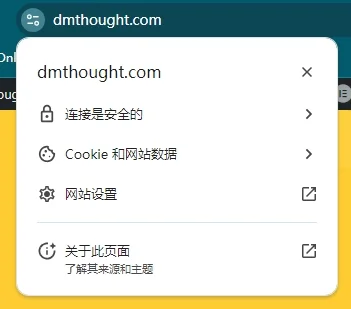
You can think about it, if the user’s browser jumps to an unsafe prompt page when he is about to visit a certain web page, and asks whether to continue accessing, will the trust level have dropped a lot at this time? The user chooses to continue to visit the website, but a pop-up window pops up in the upper left corner to remind him that the website is not safe. What do you think is the probability that he will complete the transaction on the website?
Sitemap
The site map includes all the important pages of our website, which can help search engines quickly crawl the web and ensure that important pages are not missed. You can use online tools to generate a sitemap, then go to the Google search console backend and submit the Sitemap in XML format to Google.
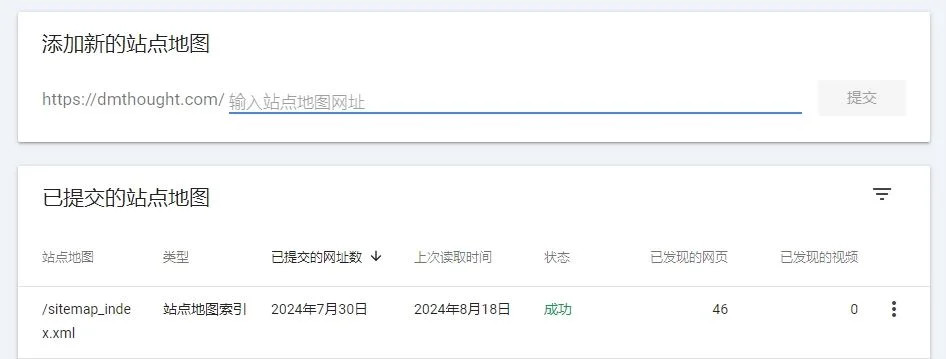
If you want to know more about site maps, you can check out my blog: ” Site Maps “.
Robots.txt file
The Robots.txt file is used to instruct search engine crawler robots which pages can and cannot be crawled. We can properly set the Robots.txt file to prevent unimportant pages from being crawled, thereby saving the crawling budget and increasing the crawling frequency of important pages.
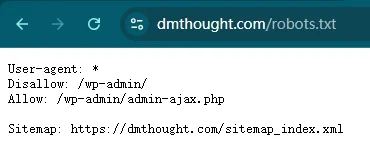
If you want to know more about the Robots.txt file, you can check out my blog: ” Robots.txt File “.
Use of Canonical tags
The Canonical tag is used to specify a canonical version of a page to avoid content duplication issues. For similar or duplicate content, using the Canonical tag can tell search engines which is the main page, thereby focusing all SEO weight on this page. This is especially important on e-commerce sites or content aggregation sites, as these types of sites tend to have a lot of duplicate content.
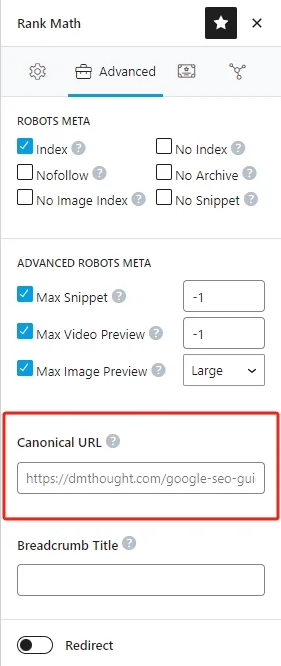
404 page
The 404 error page is the page that is displayed when a user visits a link that does not exist. A good 404 page can not only guide users back to a valid page, but also reduce user frustration. In SEO optimization, designing a friendly 404 page and ensuring that there are not too many invalid links on the website can improve user experience and reduce bounce rates.

If you want to know more about 404 related information, you can check out my blog: ” 404 and Soft 404 “.
Mobile friendly
I don’t know if you know that in 2016, Google transferred the content for indexing and ranking from the PC version to the mobile version of the website content crawled by mobile agents. In other words, Google will no longer index the content of the desktop version of your website, but the content of the mobile version. Therefore, everyone must optimize their mobile web content.
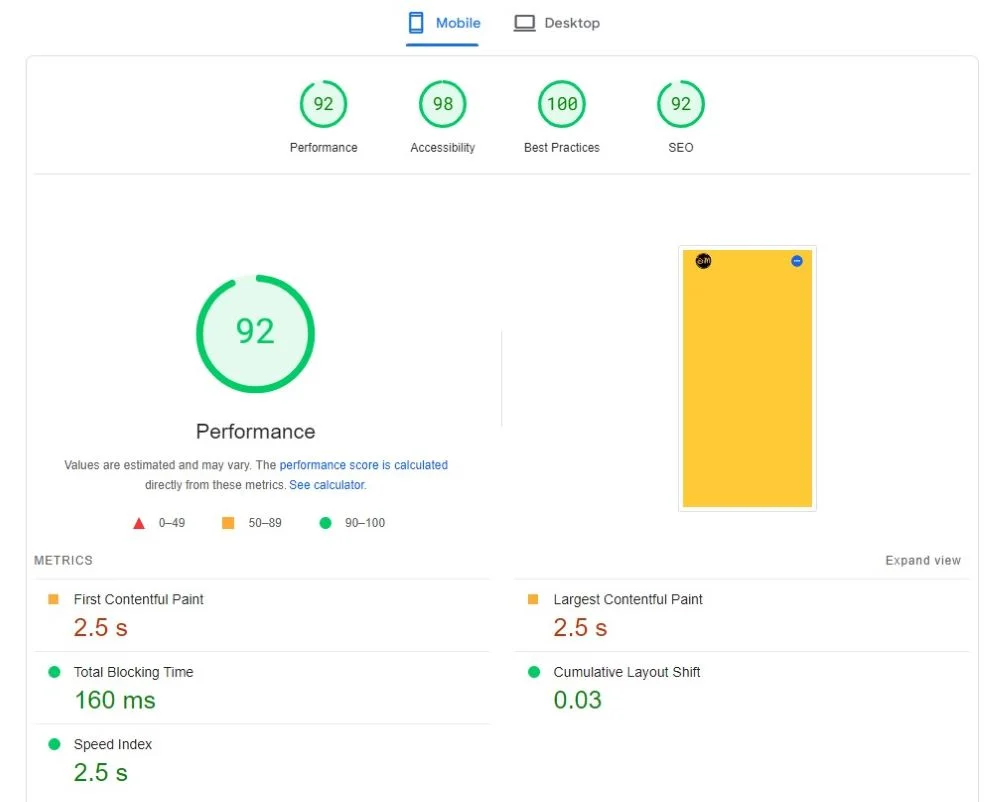
Page loading speed
Page loading speed not only affects SEO rankings, but also seriously reduces user experience. The user waited for a long time and before the page loaded successfully, he had already closed the window and found another website to look for information. If Google collects a certain amount of similar user behavior, then the ranking of this page is likely to drop.
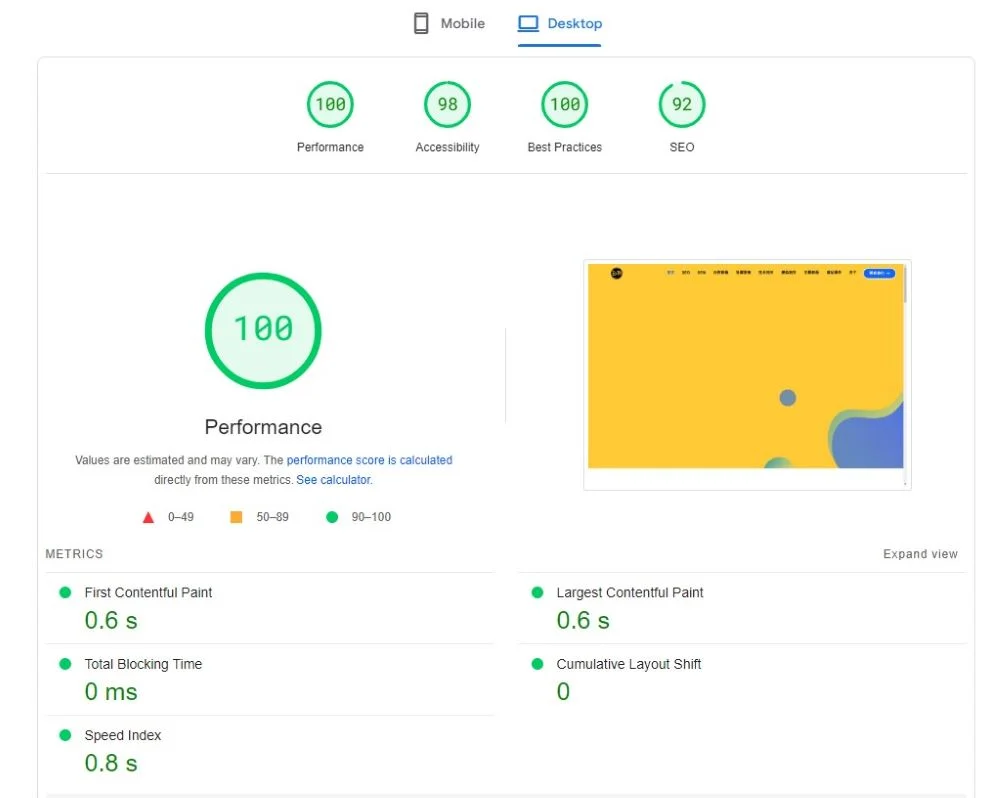
If you want to know how to optimize website speed, you can check out my blog: ” Improving WordPress Website Loading Speed “.
Core web metrics
Core Web Vitals are a set of performance indicators used by Google to measure user experience, including page loading speed, interactivity and visual stability. These metrics directly impact SEO rankings because they reflect the user’s experience when visiting the page.
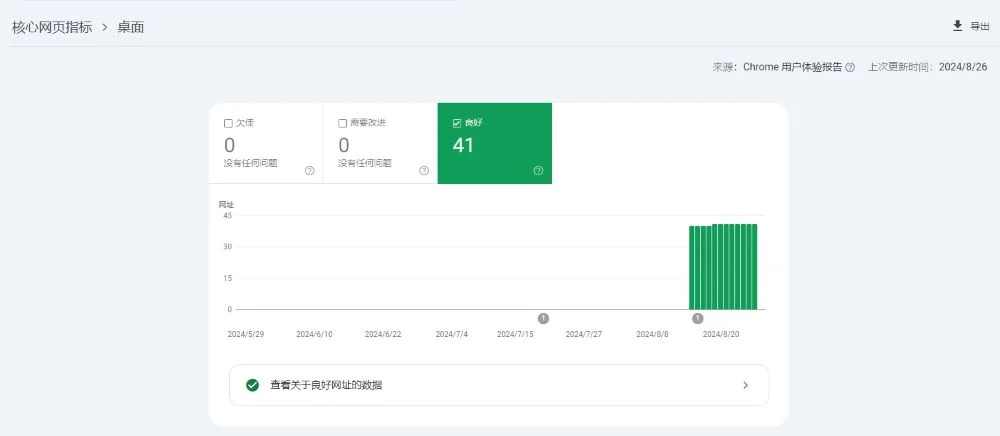
External link construction
The significance of the existence of external links is to represent the “votes” given to our website by other websites, which can increase the search engine’s trust in the website. However, external links are also divided into junk external links and high-quality external links. If your website obtains hundreds or thousands of junk external links, it will not be of much help to improve your ranking.
So how to obtain high-quality external links? You can use ahrefs to analyze competitors’ external links, find those external links that bring traffic to competitors, and collect and analyze external link types. If it is a content external link, we can consider using Brian Dean’s ” skyscraper ” technology to create better content first, and then contact the blogger to replace the external link with our new article.

Why do external links?
When our website has many external links from high-authority websites, search engines will consider the content of the website to be trustworthy, thereby improving the website’s ranking in search results. In addition, external links may also bring direct traffic, especially when the external links come from highly relevant and high-traffic websites.
Common types of external links
Next, we will introduce some common types of external links:
1. Guest Posts
Guest Posts refer to publishing articles on other relevant blogs or websites and including a link to your own website in the article or in the author profile. The external links obtained in this way are generally relatively high and difficult to obtain. Not only can you show your professional knowledge, but you also have the opportunity to direct traffic to your own website.
2. Press Releases
Publishing a press release can get external links from news websites. These news websites tend to have high weight and are very authoritative. The review of many news websites is still very strict. The press releases written by everyone should have news value and not be created purely for external links.
3. Social Media Links
Social media links are external links obtained by sharing website content through social media platforms (such as Facebook, Twitter, LinkedIn, etc.). Although most of these links are “nofollow” (that is, they do not convey SEO weight), they can increase the exposure of the content and have the opportunity to bring direct traffic.
4. Resource Page Links
Resource page linking means adding our website link to the resource page of other websites. These resource pages often contain helpful links to specific topics or industries. To obtain such links, you need to proactively contact the administrator of the resource page and explain why our content deserves to be included in their resource list.
5. Directory Submissions
Directory submission is the submission of a website to online directories, which are typically categorized by industry, topic, or geography. This type of external link building method was popular in the past, but with the update of search engine algorithms, many low-quality directories are no longer recommended.
6. Profile Links
Profile linking refers to adding a website link to the profile page when creating a user account on social media, forums, or other online platforms. Such links usually do not bring much SEO weight, but they can help increase the exposure of the website.
7. Comment Links
Comment links are made by leaving meaningful comments in the comment area of a blog or forum and attaching a website link to the comment. These types of links are often considered to be lower quality links, especially if the comment content is not related to the topic of the page. However, if the review content is relevant and valuable, and the content linked to is actually helpful to the reader, such external links can still be useful.
How to judge the quality of external links
Judging the quality of external links requires comprehensive consideration of the following factors:
1. Relevance
We don’t want to build external links for all websites, but choose high-weight websites related to our website industry to obtain external links. For example, if our website sells office furniture, external links from home blogs are obviously more valuable than external links from healthy living.
2. High weight
The external links of many low-weight websites are junk external links, and it is relatively easy to obtain external links for such websites. If the website has a large number of spam external links, it will not only not help the SEO ranking, but may also bring the risk of punishment. Therefore, we must work hard to obtain external links from high-authority websites.
3. Spam Score is low
Spam Score is a measure of a website’s potential risk for spam. If a website has a high Spam Score, links obtained from that website may have a negative impact on SEO rankings. Therefore, avoid getting external links from websites with high Spam Score to reduce risks.
How to build external links
Due to space limitations, I will not talk about the specific methods of building external links here. I will only tell you to consider two aspects.
1. Link diversity
The goal of external link building is not only quantity, but also diversity. Obtaining links from different types of websites, such as blogs, news media, industry forums, social media, etc., can make our website more natural and credible in the eyes of search engines. The ratio of Do-follow and No-follow links should also be normal, get some of both, don’t just do Dofollow links.
If you want to know more about the difference between dofollow and nofollow links, please read my blog: ” The Difference between Do-follow and No-follow Links “.
2. Anchor text diversity
Anchor text diversity means using different keywords or phrases as anchor text while avoiding over-optimization. For example, we can use brand name, core keywords, long-tail keywords, etc. as anchor text keywords. This also helps create a more natural link structure and reduces the risk of being judged as manipulative links by search engines.
SEO performance tracking and analysis
After the website officially starts to be optimized, there will be little initial data and nothing to analyze. But as time goes by, the keywords ranking on the homepage gradually increase, and the traffic they bring is also increasing. At this time, we need to analyze the website data and adjust the optimization plan appropriately according to the traffic. The following are several important tracking and analysis dimensions:
1. Number of included pages
The number of included pages is a key metric to evaluate whether search engines have crawled and indexed your website’s content. If the quality of our website is not up to par, there should be many pages that are not included. At this time, we need to prescribe the right medicine one by one.
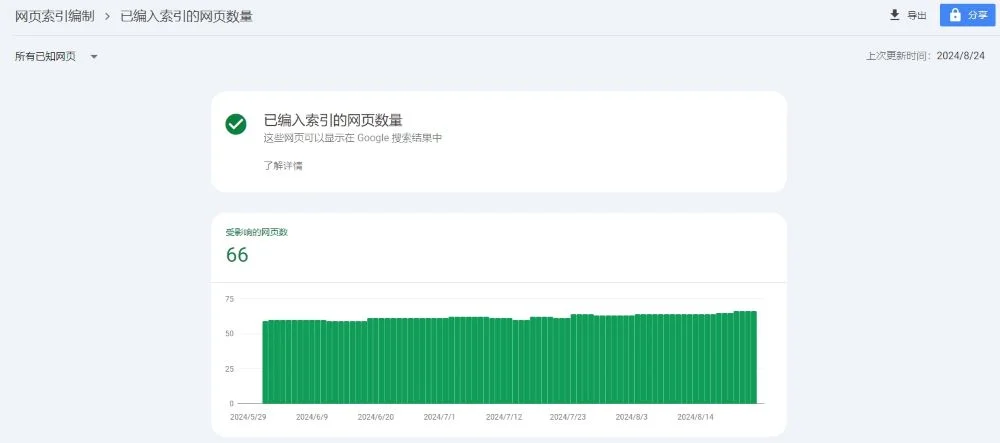
We can directly check the number of included pages and the number of not included pages in the Google Search Console backend, as well as the reasons for not being included. If you want to quickly check the number of included items, you can also check the data through “site: domain name”.
- site: domain name: know the inclusion and update status of the site
- link: domain name: know the backlink status of the site
If you want to know more about the usage of Google’s advanced search commands, you can read this blog: ” Google Advanced Search Commands “.
2. Keyword ranking tracking
Keyword ranking can be said to be the simplest and crudest way to check our SEO results. By tracking changes in a website’s keyword rankings in search engines, we can evaluate whether the optimization strategy is effective. You can pay attention to the following aspects:
- The number of keyword rankings on the homepage and how much traffic?
- The number of keyword rankings on the category page and how much traffic is there?
- How many keywords are ranked on the product page and how much traffic is there?
- The number of keyword rankings on the blog page and how much traffic is there?
- What are the keywords ranked on the third and fourth pages of search results?
- How to improve the keyword rankings on the next few pages to the homepage?
- What other potential keywords can be explored?
- As well as some other tracking indicators, you can think and summarize them yourself during the optimization process.
3. Growth trend of external links
By monitoring the growth trend of external links, we can understand whether they have a positive effect on SEO rankings. We can use tools like Ahrefs or Semrush to detect the number and quantity of external links.
Focus on how long does it take for external links to be included? Has it increased the weight of the website? Did it bring traffic?
4. User behavior analysis
Through the behavior report of Google Analytics, we can view data such as page dwell time, bounce rate, user click path, etc. A high bounce rate may mean that the content does not meet the user’s search intent, and a short time on page may indicate that the readability of the content needs to be improved. These data can help us further optimize the website.
5. Traffic trend analysis
We can use Google Analytics to monitor the overall trend of website traffic, analyze which pages attract the most visits, the geographical distribution of visitors, and traffic sources (such as organic search, social media, direct visits, etc.). If the SEO optimization direction is right, the overall traffic trend should be rising slowly.
6. Conversion rate tracking
We waste so much time and energy, and the ultimate goal is to complete conversion, that is, convert visitors into customers or achieve other specific goals (such as form submission, registration, download, etc.). Using Google Analytics’ goal conversion tracking function, we can monitor the conversion performance of different keywords, pages or traffic sources.
Common SEO optimization mistakes
There are some common mistakes that many novice and experienced optimizers make when doing SEO optimization. Not only do these mistakes affect your website’s rankings, they can also lead to search engine penalties. Therefore, it is crucial to understand these common mistakes and know how to avoid them.
Common SEO mistakes made by novices
These misunderstandings often appear among people who have little knowledge of Google SEO optimization.
1. Keyword stuffing
Novices can easily fall into the misunderstanding of “the more keywords, the better”, resulting in too high keyword density on the web page. While proper keyword usage can help with rankings, overstuffing your content can make your content look unnatural and may even lead to search engine penalties.
2. Ignore mobile optimization
Many novices ignore mobile optimization and are still stuck in the era when PC pages only need to look good. Websites that are not optimized for mobile devices may lose a large number of potential users, while also affecting the search engine ranking of the website.
3. Low quality external links
In order to quickly improve their rankings, some people may choose to purchase or exchange low-quality external links in large quantities. Not only is this approach ineffective, it may also be considered “cheating” by search engines, thereby lowering the overall ranking.
4. Ignore page loading speed
Page load speed is an important ranking factor, but newbies may overlook this, affecting user experience and rankings. You can search for some common speed optimization methods to solve this problem.
5. Unreasonable internal links
Internal links help improve the structure and user experience of the website, but novices may use internal links excessively or unreasonably, such as deliberately inserting keywords and then leading to the page they want to rank.
How to correct these errors
Now that we know what the problem is, let’s look at how to solve the corresponding problem.
1. Use keywords appropriately
The use of keywords should be natural. You can use related keyword tools to analyze the keyword density of competitor web pages and refer to their keyword distribution. At the same time, focus on semantic search and use long-tail keywords to improve the relevance of your content.
2. Make sure it’s mobile-friendly
Use responsive design to ensure your website behaves consistently across devices. Test and optimize the mobile user experience to ensure fast content loading and easy operation.
3. Pay attention to high-quality external links
Quality of external links trumps quantity. Choose websites with high weight that are relevant to your industry to build external links, and avoid buying low-quality external links. Attracting natural external links by creating high-quality content is a long-term effective strategy.
4. Improve page loading speed
Use tools like Google PageSpeed Insights to analyze page loading speed issues and make optimizations based on recommendations. For example, compressing images, using browser cache, reducing redirects, etc. are all effective measures to improve loading speed.
5. Optimize internal link structure
Internal links should help users and search engines better understand the website structure. Links should be natural and meaningful, don’t over-add internal links for the sake of optimization.
SEO practical cases
I will use this blog website as a case for this content. After all, if a person says that he knows Google SEO, but cannot even rank his own website, he will understand the water content in it.
Let me show you the current number of blogs on my website, there are only 27 in total. Because I am at work, there is no regular update time. . .
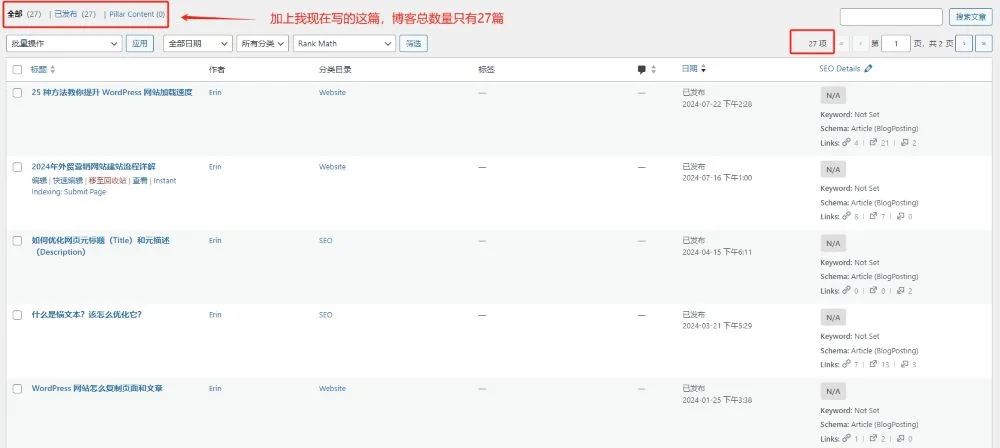
In order to make it easier for everyone to see the ranking position, I turned on the SEOquake plug-in. The interface content may not be as concise as the normal search results, but the ranking position is the same.
Everyone ignores the fact that my favicon suddenly disappeared. I only found out about it in the past two days. I will deal with it after I finish writing this blog. . .
Because this blog is the first blog in the Google SEO tutorial series, let’s first take a look at the ranking of the Google SEO tutorial page that was just released not long ago.
” Free Google SEO Tutorial ” is currently ranked No. 2 on the homepage. The page was published on August 18, 2024 (the screenshot has time). The time when I wrote this blog was August 27.
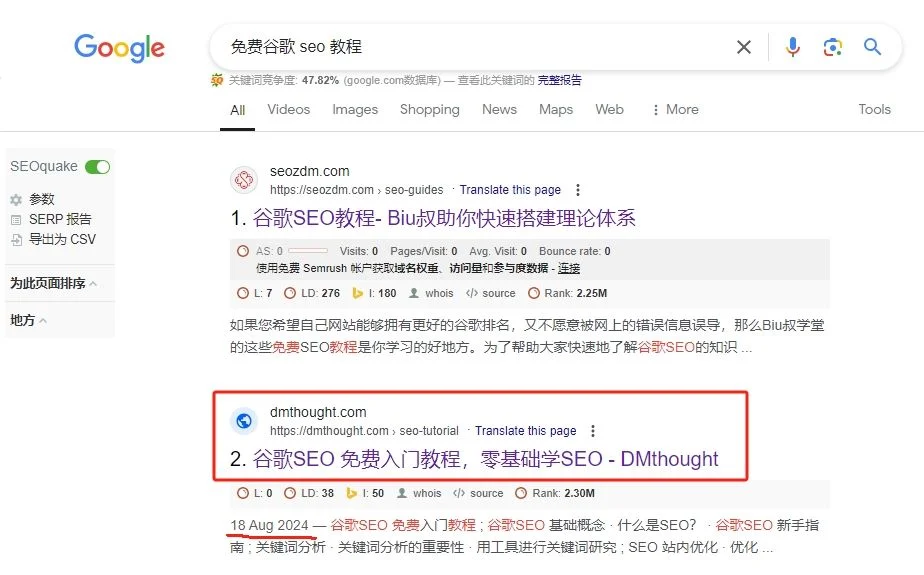
The competition for the keyword ” Google SEO tutorial ” is relatively fierce, but currently my website is also ranked on page 4, 33rd. I have been tracking the ranking of this keyword these days and watching it improve every day. Page 7 to page 6 to page 5 and then to page 4 today.
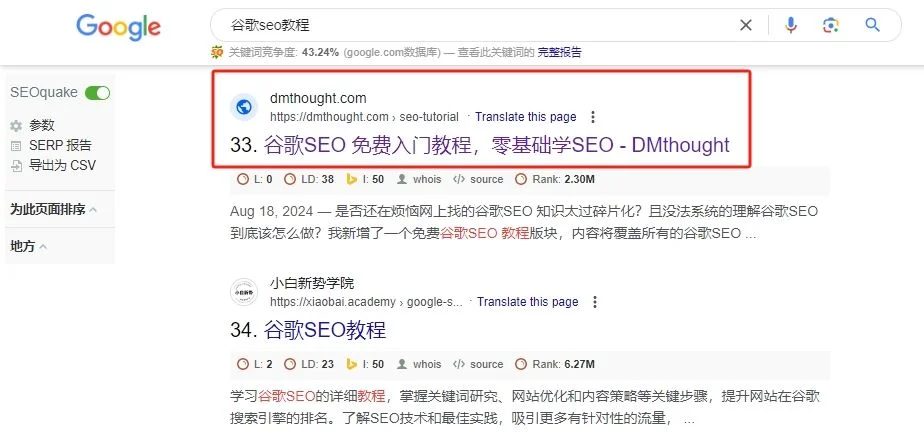
Next, let’s take a look at the rankings of other blogs on my website.
1. “ WordPress Theme Recommendation ” ranks No. 1 on the homepage
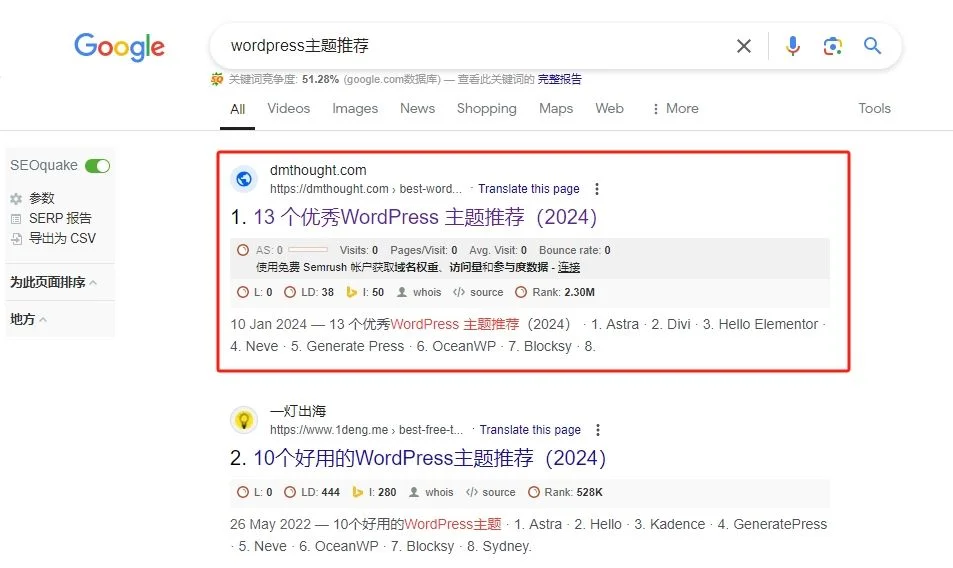
2. “ WordPress Plug-in Recommendation ” ranks No. 1 on the homepage
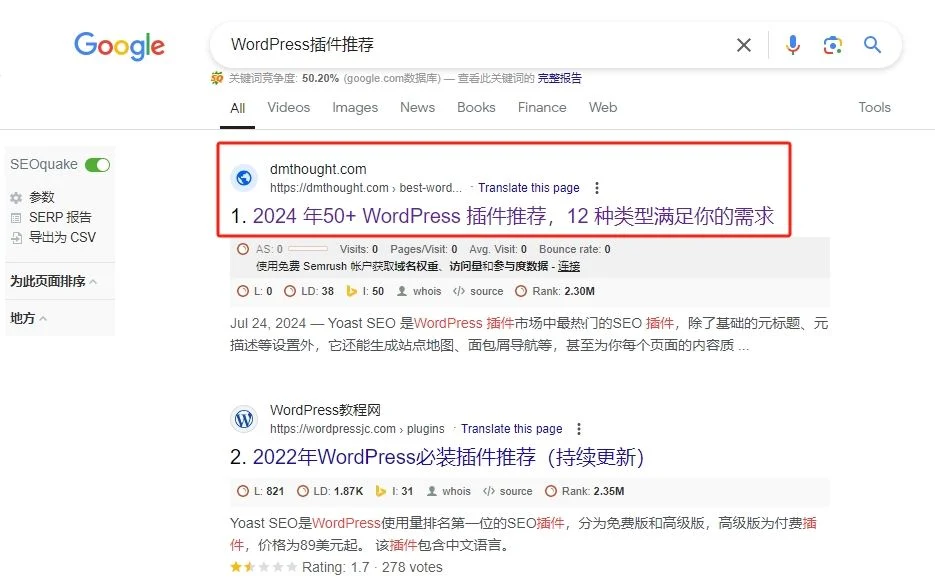
3. “ Search command ” ranks 2nd on the homepage
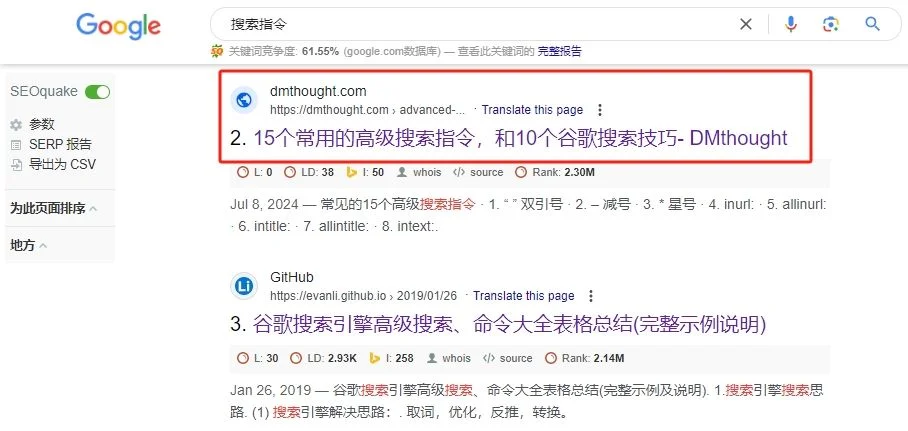
4. “ Search Engine Principles ” ranks 2nd on the homepage
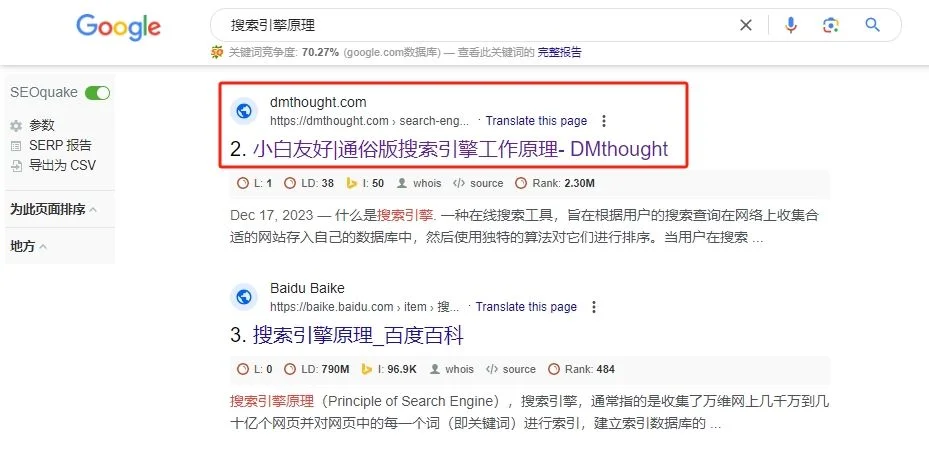
5. “ Anchor text ” ranks 3rd on the homepage
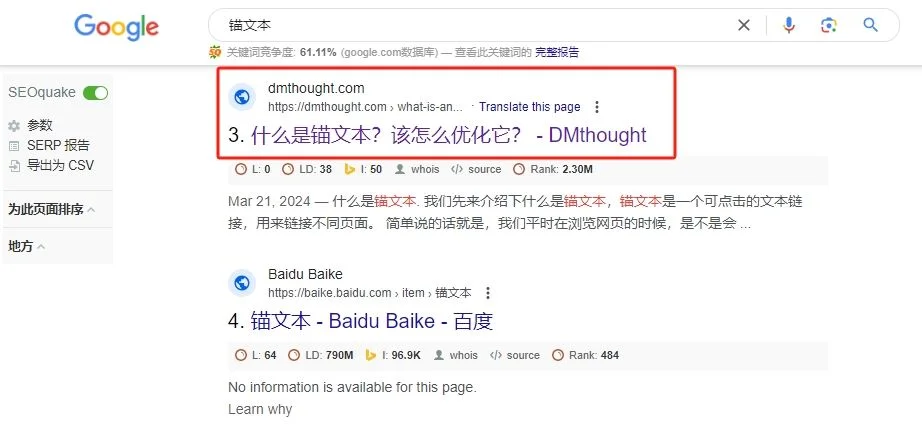
6. “ Sitemap ” is ranked 5th on the homepage, and the ones ranked first are Google’s official documents.
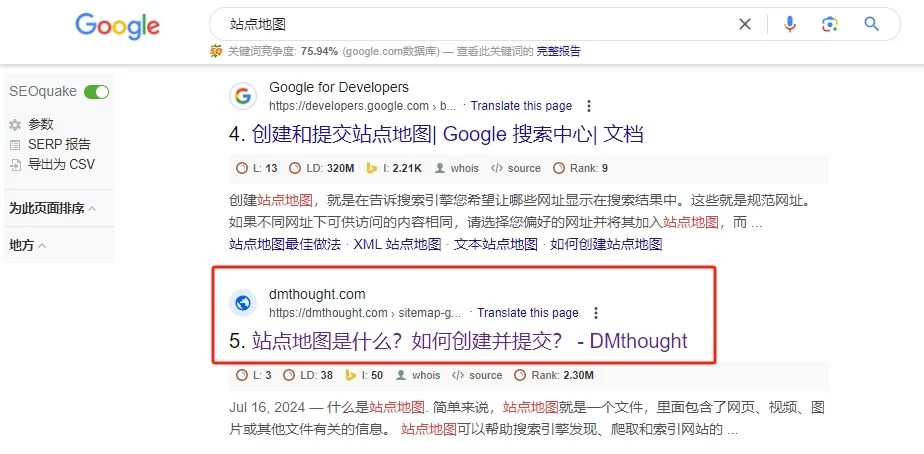
7. “ shopify and WordPress ” ranked 1st on the home page
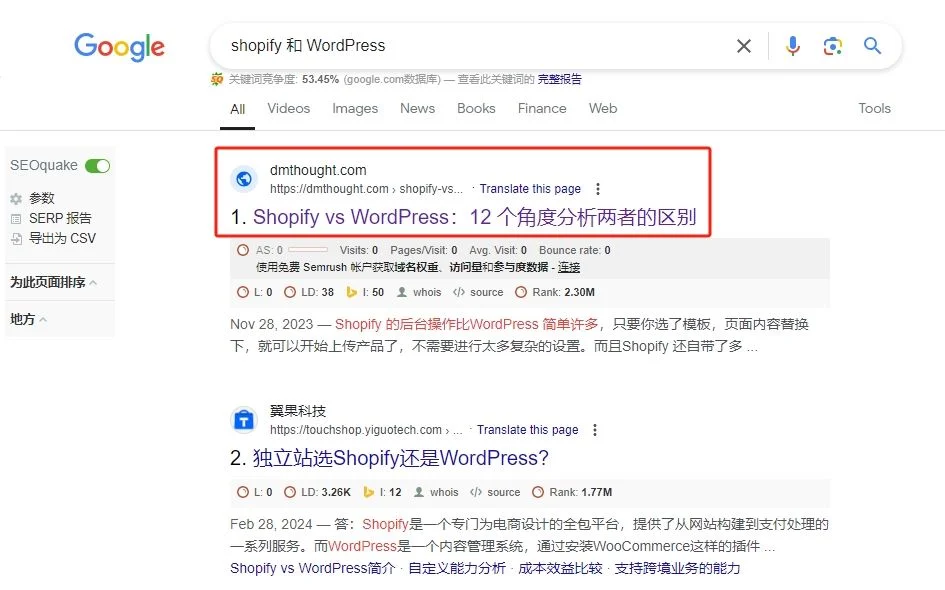
8. “ do-follow and no-follow ” ranks 2nd on the homepage
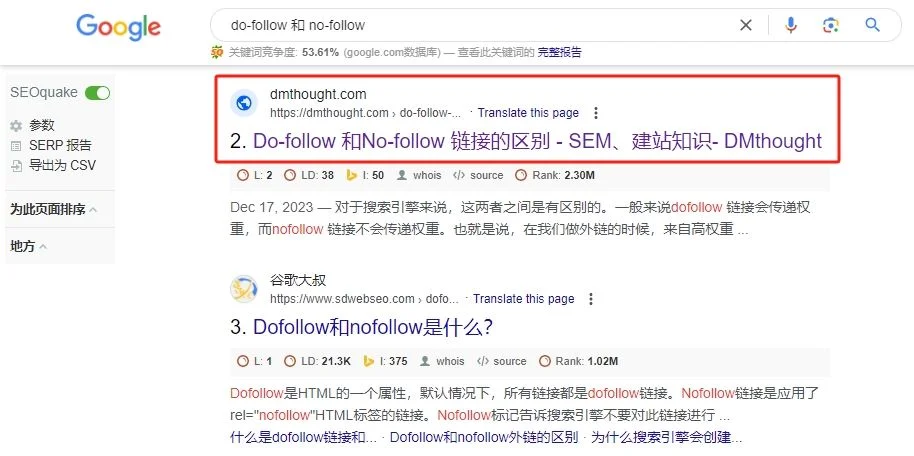
9. “ Search intent ” ranks 2nd on the homepage
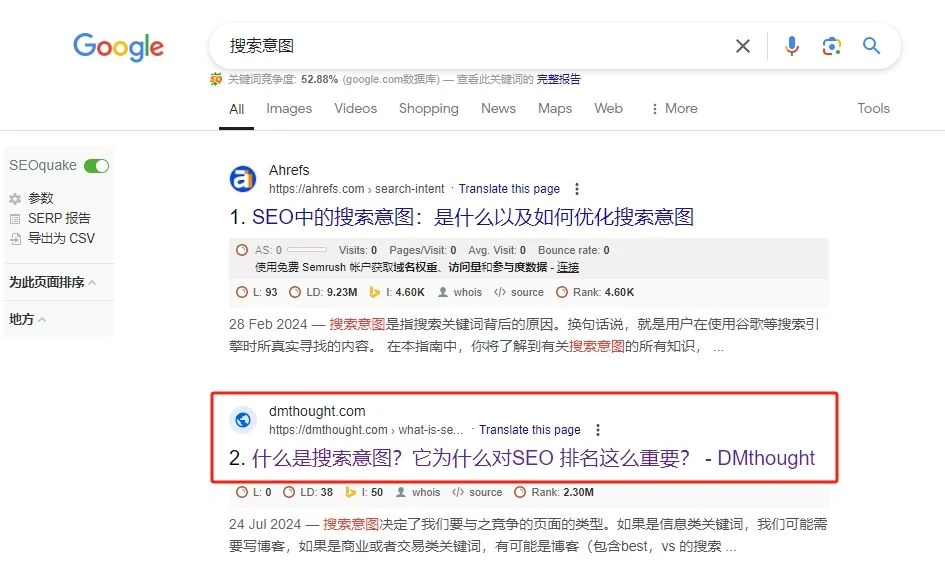
10. “ Google SERP ” ranks 1st on the homepage
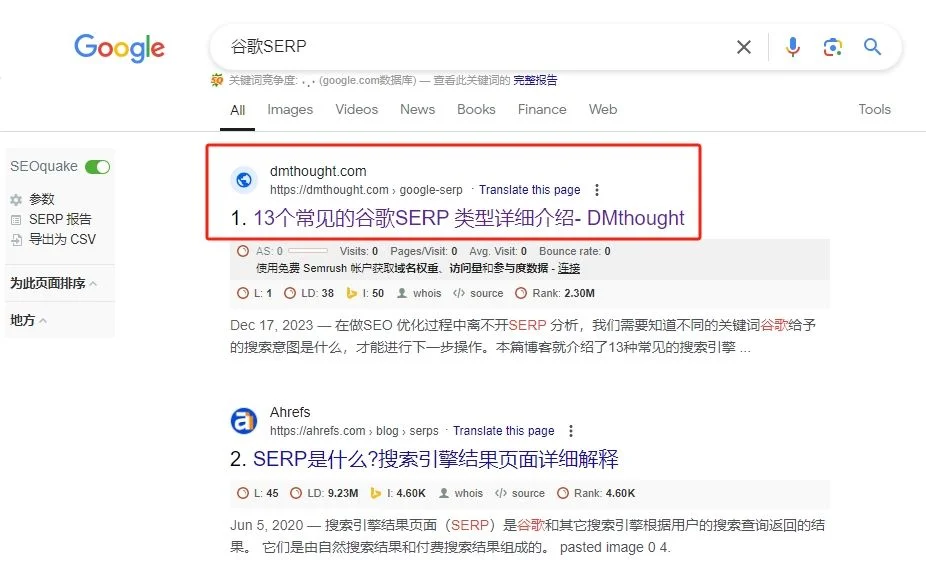
Due to the limited length of the article, I will cut it off to 10. I don’t know if you have noticed it. Although the number of blogs on my website is very small and the update frequency is very random, most of the blogs rank very well. And what I cut was not long keywords, but short core words, but my website could still be ranked on the homepage.
My website has no external links and relies entirely on content to achieve this ranking. The content is entirely based on my work experience. Of course, before writing, I will definitely browse what other people have written, but after determining the framework of the article, I typed out all the words word by word, and they are 100% original.
I hope that when you do Google SEO, you can also ensure the originality and high quality of the content, so that it will be easier to get rankings. However, if you are building an English website, because the competition is too fierce, you still need to obtain some high-quality external links, so that the website has a greater chance of getting a good ranking.
Updated on October 10, 2024:
After returning from the National Day, I found that the two keywords ” Google seo ” and ” Google seo tutorial ” were already ranked on the homepage, ranking fifth and second respectively. This result is very important to my personal blog website that has been in operation for such a short time. It should be considered pretty good, the IP is targeting the United States.
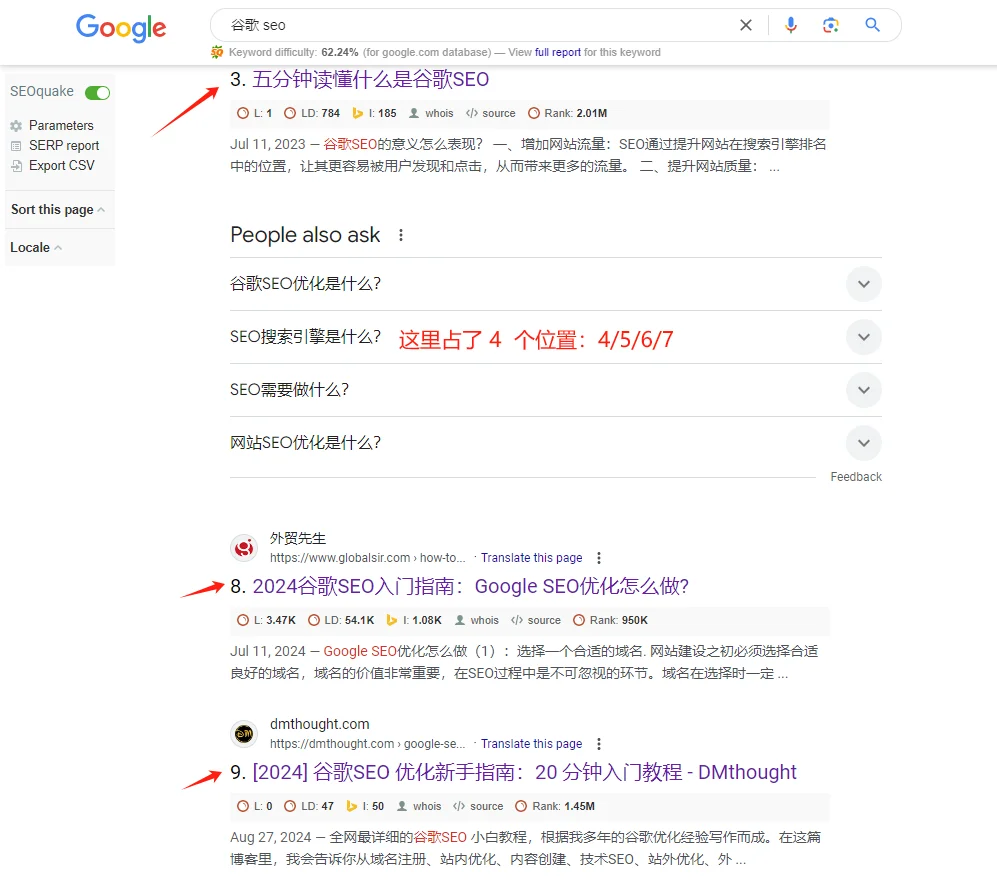
Let’s take a look at the comparison of search results website data for the keyword “Google seo”
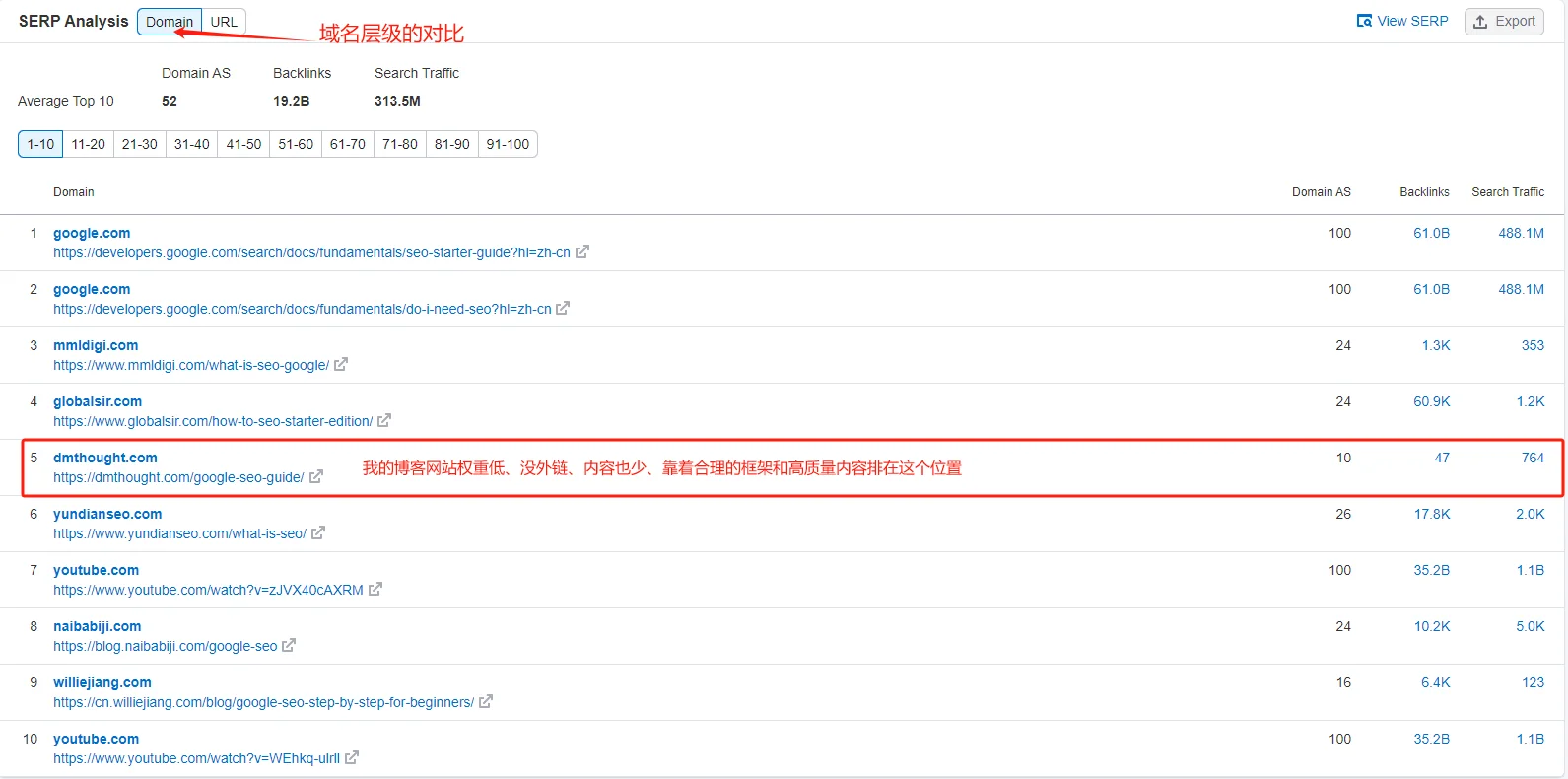
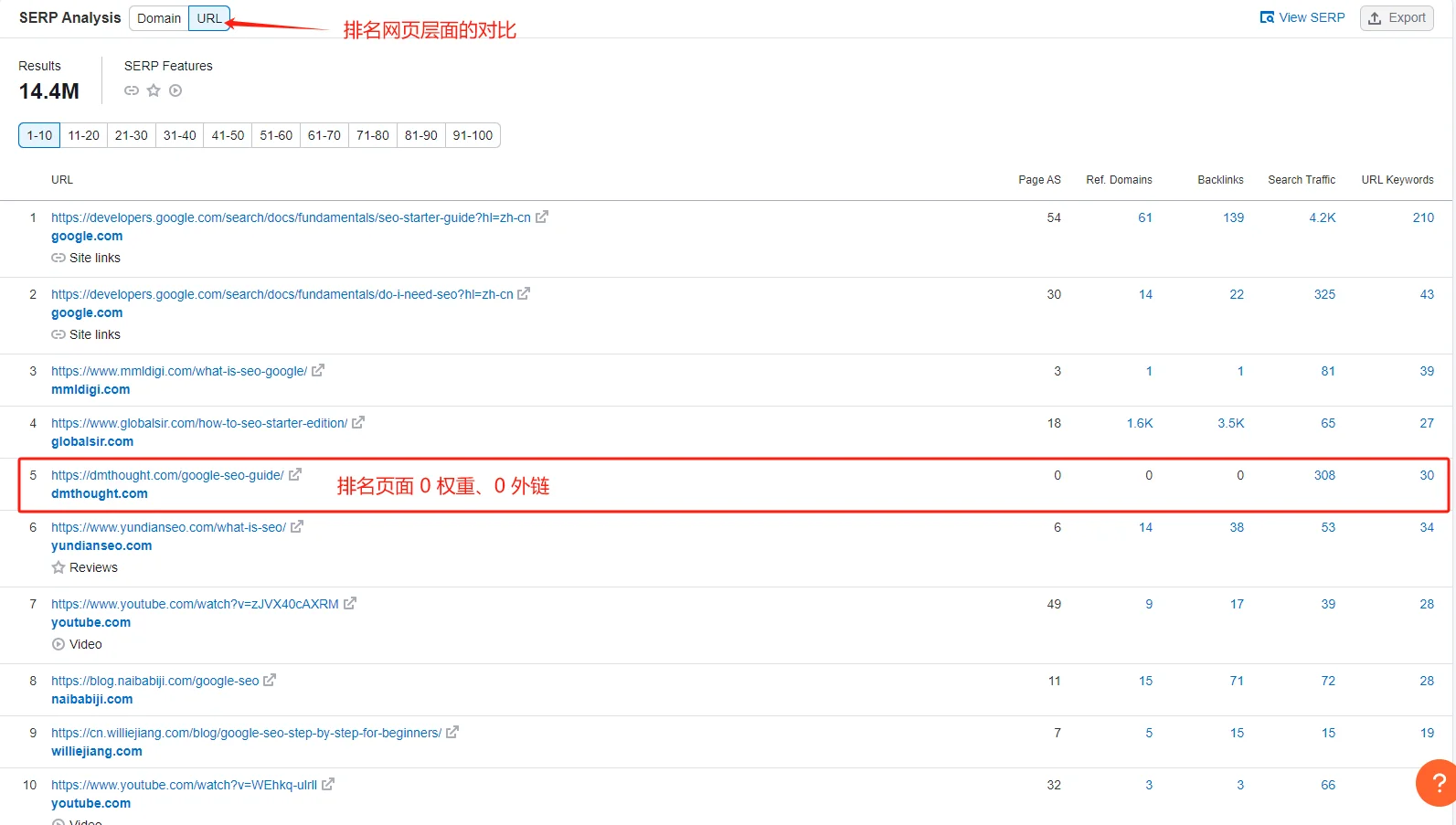
Let’s take a look at the comparison of search results and website data for the keyword “Google seo tutorial”
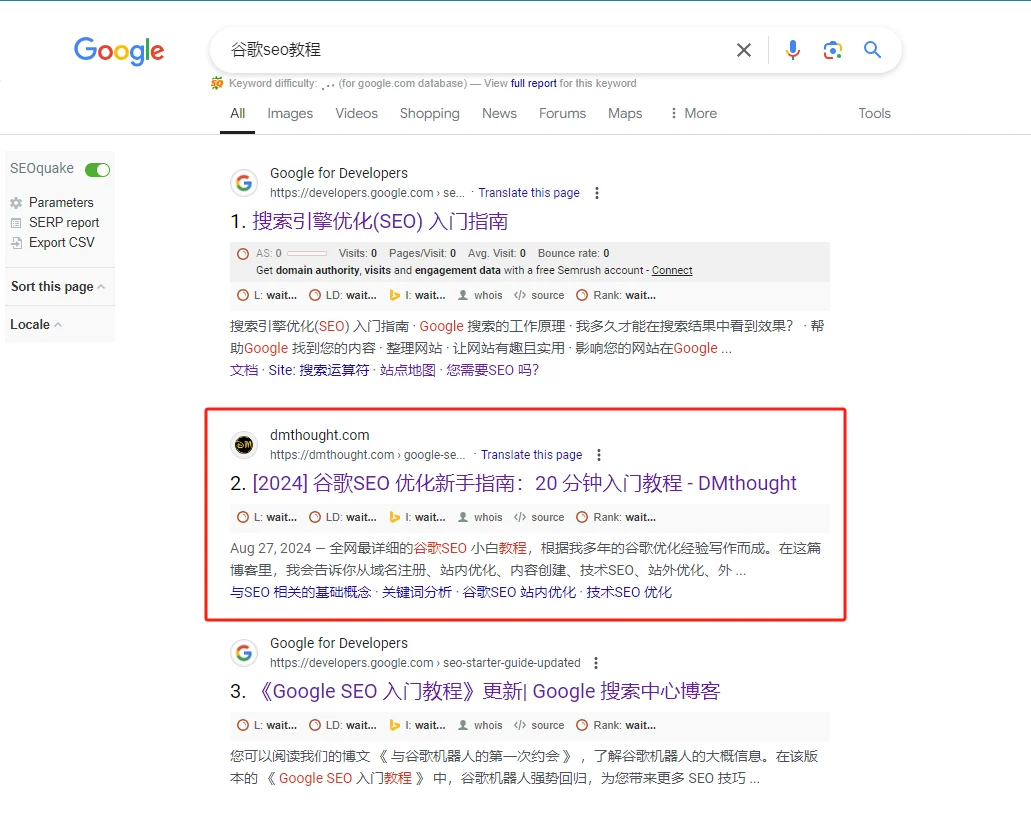
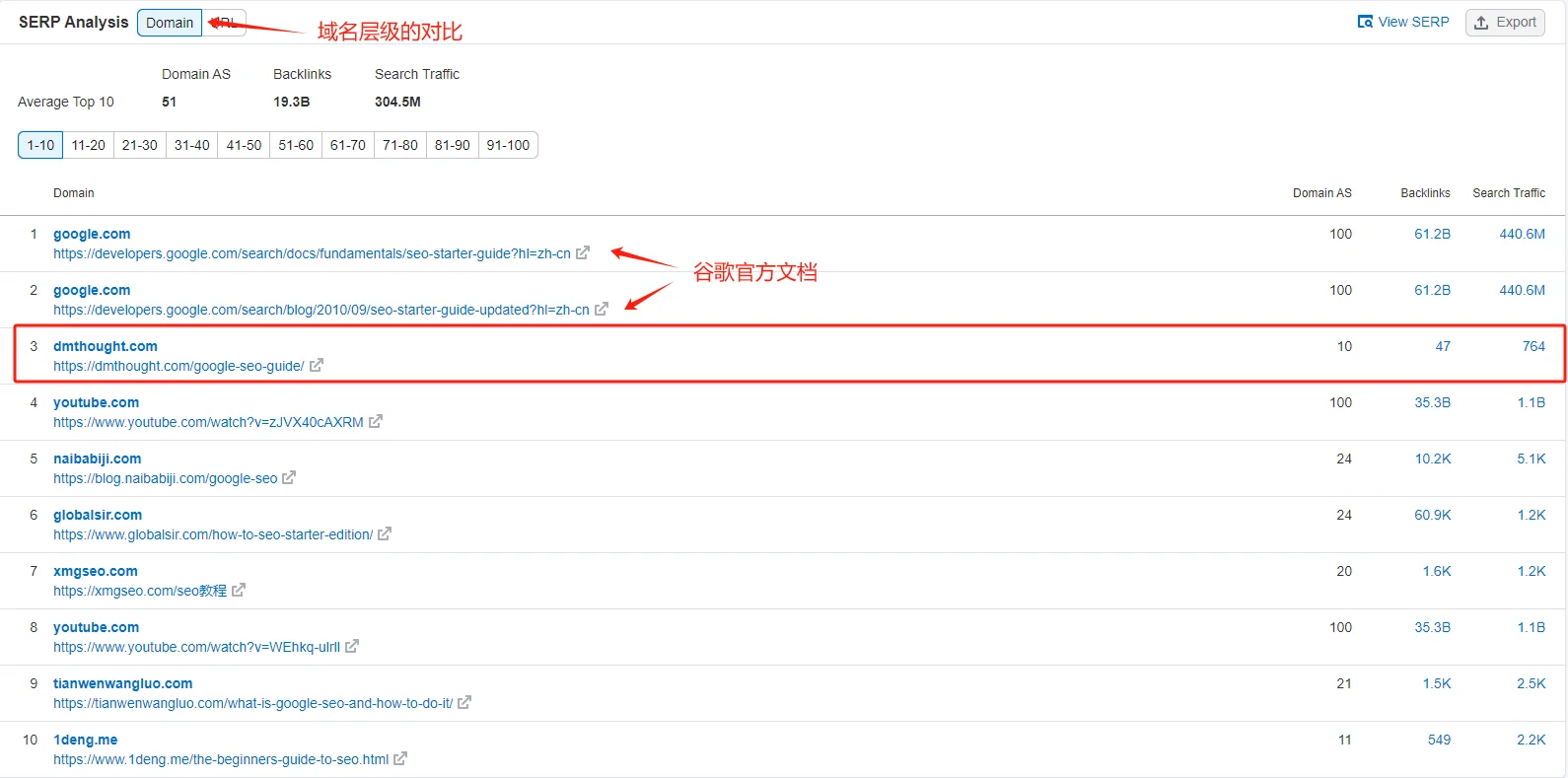
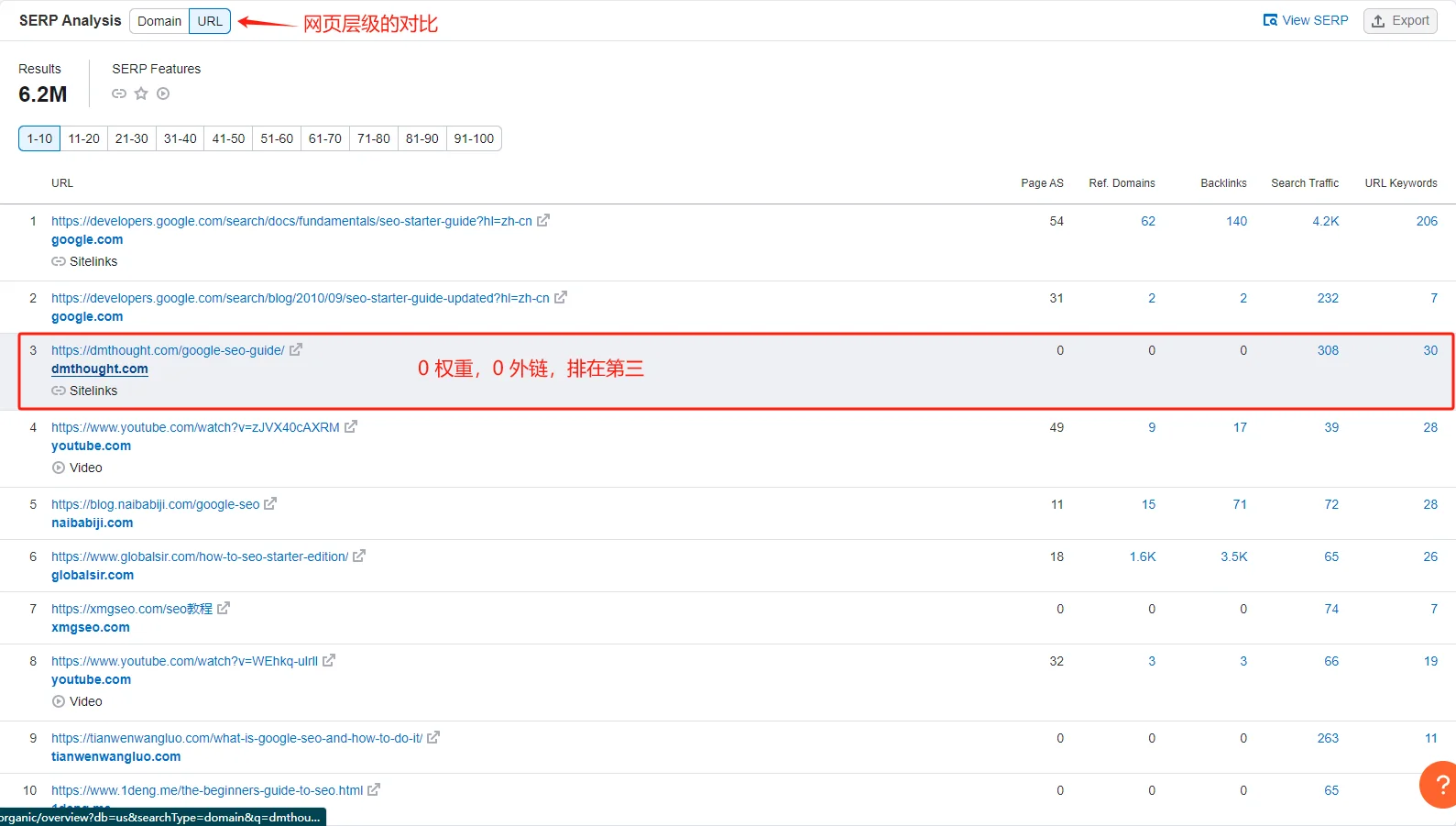
I thought about it and there should be several reasons:
- Compared with English ranking, Chinese ranking will be simpler. Of course, it also depends on the industry and the difficulty of keyword ranking. For example, the keyword “Google SEO” must be difficult to a certain extent. After all, there are so many SEO agency operations services on the market. business.
- Although I have a small number of blogs, the quality is relatively high. It takes me three or four days to write many blogs. Basically, I type every word in each paragraph while thinking about it. I output a lot of my own ideas and experiences, which is very time-consuming. Time and energy.
- The website framework structure is not bad, and the design is also pretty good-looking. The user experience should be better. This is actually inseparable from the content. The two together can retain users.
Recommended commonly used Google SEO tools
Using tools can improve our work efficiency and monitor SEO optimization effects. The following are some commonly used Google SEO tools:
1. Keyword Research Tools
- Google Keyword Planner : This is a free keyword research tool officially provided by Google. It can help you discover keywords related to your business, view the search volume and competition level of each keyword, and determine the keywords most suitable for optimization.
- Ahrefs : Ahrefs is a powerful paid tool that provides in-depth keyword analysis data, including keyword difficulty, search volume, click-through rate, etc., and can also analyze competitors’ keyword strategies.
- SEMrush : This is also a powerful paid tool that can not only conduct keyword research, but also provides competitor analysis, keyword difficulty assessment and other functions, which is very suitable for experienced SEO practitioners.
2. Website analysis tools
- Google Analytics : Google Analytics is an essential website traffic analysis tool. It can help you track the source, behavior, conversion path, etc. of visitors to optimize user experience and SEO strategies.
- Google Search Console : This tool allows you to view the performance of your website in Google search, such as inclusion status, clicks, impressions, average ranking, etc. It can also be used to submit Sitemaps and fix problem pages.
3. External link building tools
- Moz Link Explorer : The external link analysis tool provided by Moz allows you to view your own external links and those of your competitors. By analyzing the source and quality of external links, you can develop a more effective external link building strategy.
- SEMrush Backlink Analytics : In addition to its powerful keyword analysis function, SEMrush also provides detailed external link analysis reports to help you identify high-quality external link opportunities and increase the weight of your website.
- Ahrefs Backlink Checker : This is a very popular backlink analysis tool that can help you check your competitors’ backlinks and find high-quality backlink opportunities. It is said that the backlink data is more accurate than SEMrush.
4. Technical SEO Tools
- Google PageSpeed Insights : This tool can analyze the loading speed of web pages and provide specific suggestions to improve performance, helping us optimize the technical SEO of the page.
- Screaming Frog SEO Spider : Screaming Frog is a website crawler tool that can quickly crawl websites and generate detailed technical SEO reports, including title tags, meta descriptions, H tags, image Alt text, dead links, etc.
Google SEO learning resource recommendations
Finally, I recommend some great learning resources, including books, online courses, blogs, YouTube videos, and podcasts.
1. Book recommendations
- ” The Art of SEO “ : This book is known as the “SEO Bible”, covering SEO strategies and techniques from basic to advanced, and is suitable for learners who want to understand SEO in depth.
- ” SEO Practical Code “ : This book is a classic book in the field of domestic SEO. It covers the basic concepts, practical skills and case analysis of SEO. It is very suitable as an introductory book to SEO.
2. Online courses and blog recommendations
- DMthought : This is a blog website I run myself. It focuses on sharing SEO technology and practical experience. The content covers a wide range and is suitable for all types of SEO learners.
- Google’s SEO Starter Guide : This is Google’s official SEO starter guide, suitable for beginners to understand the basics of search engine optimization.
- Moz Blog : Moz provides a large number of high-quality blog articles about SEO, covering keyword research, link building, content marketing and other aspects.
- Coursera – SEO Specialization : The SEO specialization course provided by Coursera covers all aspects of SEO and is suitable for systematic learning.
3. YouTube video and podcast recommendations
- Google Search Central YouTube Channel : This is Google’s official SEO video channel, which regularly releases the latest developments and optimization suggestions about SEO.
- The Authority Hacker Podcast : This is a podcast focused on SEO and content marketing, providing practical SEO tips and strategies, suitable for listening to on the go.
- Ahrefs YouTube Channel : Ahrefs’ official YouTube channel provides various SEO techniques, tool usage tutorials and practical case analysis.
Summarize
This Google SEO Beginner’s Guide is just a simplified version of the Google SEO optimization process. Some sections only describe the general direction of operation. During the actual operation, you still need to make adjustments according to the actual situation of your website.
SEO optimization is a long process, and you may not see results in the short term, but don’t give up. All the early work is laying the foundation. When a certain amount is accumulated, there will definitely be an explosive growth in traffic.
If you want to get traffic quickly, you can also consider SEM, which is Google Advertising or Baidu Advertising. Since they are both the jobs I am currently engaged in, I will also write some articles about SEM in the future. If you have any questions about some Google SEO optimization techniques, you can leave a message in the comment area and let us discuss together. You can also follow me, and I will update some of my thoughts and learning records on SEO/SEM work from time to time.

